-
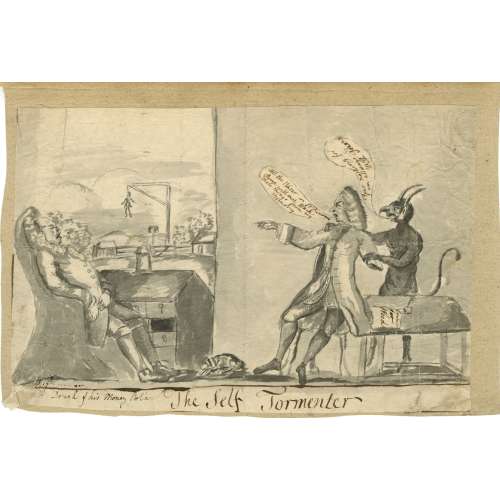 Ink drawing on watermarked paper by an anonymous artist, British or American. Original pen and ink with manuscript text. About 7 x 10-1/2 inches, Vander Ley type watermark (Churchill 321), mounted to old laid paper; several corners chipped, some creasing, soiling, etc. Np, Late 18th-century.
Ink drawing on watermarked paper by an anonymous artist, British or American. Original pen and ink with manuscript text. About 7 x 10-1/2 inches, Vander Ley type watermark (Churchill 321), mounted to old laid paper; several corners chipped, some creasing, soiling, etc. Np, Late 18th-century. -
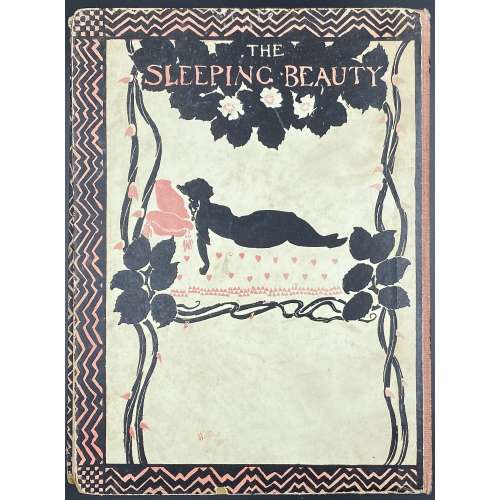 Title: THE SLEEPING | BEAUTY | TOLD BY C S EVANS | AND ILLUSTRATED BY | ARTHUR RACKHAM | LONDON WILLIAM HEINEMANN | PHILADELPHIA J B LIPPINCOTT Co || T.p. verso: LONDON WILLIAM HEINEMANN, 1920. Pagination: [1, 2] – h.t. / advert., [3, 4] – “WH” publisher’s device / frontis., [5, 6] – pictorial t.p. / publisher, year, [7, 8] – silhouette girls / Briar rose w/pasted offset ill., [9] 10-110 [2] – imprint / blank]. Collation: 8vo; B-G8, 3 double-leaf 3-colour woodcut illustrations extraneous to collation, in-text woodcuts. Illustrations: 25 full-page silhouettes, comprising 9 in colour (frontispiece and 4 double plates)--and 16 in black (including 4 double illustrations); one mounted coloured plate; silhouette head- and tailpieces and other silhouettes throughout the text, in black. Binding: Quarter cloth with black lettering, pictorial boards, pictorial endpapers. Size: 26 x 19.5. 1st edition. Inscription to h.t.: "To Dear Julia, Xmas 1947."
Title: THE SLEEPING | BEAUTY | TOLD BY C S EVANS | AND ILLUSTRATED BY | ARTHUR RACKHAM | LONDON WILLIAM HEINEMANN | PHILADELPHIA J B LIPPINCOTT Co || T.p. verso: LONDON WILLIAM HEINEMANN, 1920. Pagination: [1, 2] – h.t. / advert., [3, 4] – “WH” publisher’s device / frontis., [5, 6] – pictorial t.p. / publisher, year, [7, 8] – silhouette girls / Briar rose w/pasted offset ill., [9] 10-110 [2] – imprint / blank]. Collation: 8vo; B-G8, 3 double-leaf 3-colour woodcut illustrations extraneous to collation, in-text woodcuts. Illustrations: 25 full-page silhouettes, comprising 9 in colour (frontispiece and 4 double plates)--and 16 in black (including 4 double illustrations); one mounted coloured plate; silhouette head- and tailpieces and other silhouettes throughout the text, in black. Binding: Quarter cloth with black lettering, pictorial boards, pictorial endpapers. Size: 26 x 19.5. 1st edition. Inscription to h.t.: "To Dear Julia, Xmas 1947." -
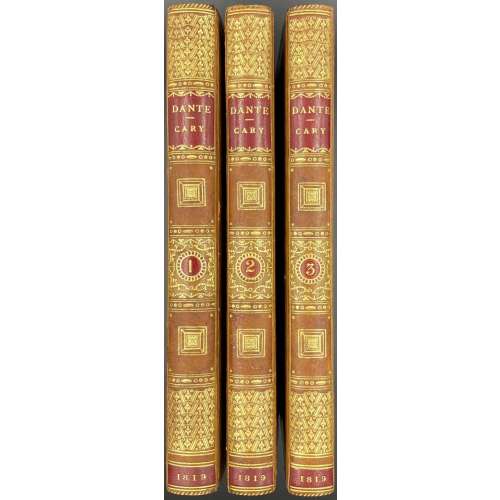 Title page: THE | VISION; | OR | HELL, PURGATORY, AND PARADISE, | OF | DANTE ALIGHIERI. | TRANSLATED BY | THE REV. HENRY FRANCIS CARY, A. M. | IN THREE VOLUMES. | THE SECOND EDITION CORRECTED. | WITH THE LIFE OF DANTE, ADDITIONAL NOTES, | AND AN INDEX. | VOL. I. (–II, –III.) | — | LONDON: | PRINTED FOR | TAYLOR AND HESSEY, FLEET STREET. | 1819. || Pagination: (I) [2] – t.p. / blank, [4] – preface, [2] – contents / blank, [2] – errata / blank, [i] ii-lii – life of Dante, [1-3] 4-303+colophon [304 blank]; (II) [2] – t.p. / blank, [v] vi-xi [xii blank] – chronological view, [1-3] 4-309 [310 colophon]; (3) [2] – t.p. / blank, [1-3] 4-297 [298 blank], [28 index, colophon]; as called for by Royal Academy. Collation: 8vo; (1) π5 b-d8 e2 B-U8; (2) π5 B-U8 X2 Y1; (3) π1 B-U8 X8 X3. Binding: 22 x 14 cm each, three volumes uniformly bound by Morrell (stamp-signed on FEP verso) in slightly marbled polished calf, gilt dentelle border to boards and inside, gilt ornamental spine with red morocco labels, peacock marbled endpapers, extra vergé flyleaves in front and back, AEG. Edition: 2nd, corrected. The 1st edition was published by J. Barfield in 1814. Contributors: Dante Alighieri (Italian, 1265 – 1321) – author. Henry Francis Cary (British, 1772 – 1844) – translator. James Augustus Hessey (British, 1785 – 1870), Taylor and Hessey (London) – publisher. Thomas Miller (British, fl. 1815 – 1819) – printer.
Title page: THE | VISION; | OR | HELL, PURGATORY, AND PARADISE, | OF | DANTE ALIGHIERI. | TRANSLATED BY | THE REV. HENRY FRANCIS CARY, A. M. | IN THREE VOLUMES. | THE SECOND EDITION CORRECTED. | WITH THE LIFE OF DANTE, ADDITIONAL NOTES, | AND AN INDEX. | VOL. I. (–II, –III.) | — | LONDON: | PRINTED FOR | TAYLOR AND HESSEY, FLEET STREET. | 1819. || Pagination: (I) [2] – t.p. / blank, [4] – preface, [2] – contents / blank, [2] – errata / blank, [i] ii-lii – life of Dante, [1-3] 4-303+colophon [304 blank]; (II) [2] – t.p. / blank, [v] vi-xi [xii blank] – chronological view, [1-3] 4-309 [310 colophon]; (3) [2] – t.p. / blank, [1-3] 4-297 [298 blank], [28 index, colophon]; as called for by Royal Academy. Collation: 8vo; (1) π5 b-d8 e2 B-U8; (2) π5 B-U8 X2 Y1; (3) π1 B-U8 X8 X3. Binding: 22 x 14 cm each, three volumes uniformly bound by Morrell (stamp-signed on FEP verso) in slightly marbled polished calf, gilt dentelle border to boards and inside, gilt ornamental spine with red morocco labels, peacock marbled endpapers, extra vergé flyleaves in front and back, AEG. Edition: 2nd, corrected. The 1st edition was published by J. Barfield in 1814. Contributors: Dante Alighieri (Italian, 1265 – 1321) – author. Henry Francis Cary (British, 1772 – 1844) – translator. James Augustus Hessey (British, 1785 – 1870), Taylor and Hessey (London) – publisher. Thomas Miller (British, fl. 1815 – 1819) – printer. -
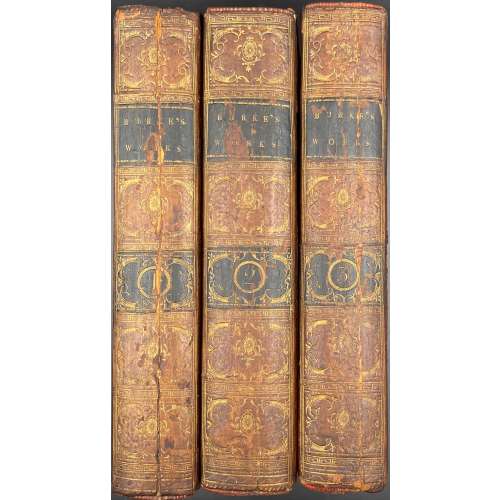 Vol. 1: THE | WORKS | OF THE | RIGHT HONOURABLE | EDMUND BURKE, | COLLECTED IN THREE VOLUMES. | VOL. I. | DUBLIN: | PRINTED FOR R. CROSS, W. WILSON, P. WO-| GAN, L. WHITE, P. BYRNE, A. GRUEBER, J. MOORE, | W. JONES, W. M’KENZIE, H. WATTS, J. RICE, | AND G. FOLINGSBY. | 1792.|| Pagination: 2 blank leaves, [2] - t.p. /blank, [2] - contents / blank, [2] - f.t. / blank, [3] 4-61 [62] - blank, [2] - f.t / blank, [4] contents, 65-580, 1 blank leaf. Collation: 8vo; π2 B-Z8 Aa-Oo8 Pp4. Vol. 2: THE | WORKS | OF THE | RIGHT HONOURABLE | EDMUND BURKE, | COLLECTED IN THREE VOLUMES. | VOL. II. | DUBLIN: | Printed by William Porter, | For R. Cross, W. Wilson, P. Wogan, L. White, P. Byrne, W. M’kenzie, J. Moore, A. Grueber, W. Jones, H. Watts, J. Rice, And G. Folingsby. | M.DCC.XCIII.|| Pagination: 2 blank leaves, [2] - t.p. /blank, [2] - contents / cont., [2] - f.t. / blank, [3] 4-655 [656 blank], 2 blank leaves. Collation: 8vo; π2 B-Z8 Aa-Tt8. Vol. 3: THE | WORKS | OF THE | RIGHT HONOURABLE | EDMUND BURKE, | COLLECTED IN THREE VOLUMES. | VOL. III. | DUBLIN: | PRINTED FOR R. CROSS, W. WILSON, P. WO-| GAN, L. WHITE, P. BYRNE, A. GRUEBER, J. MOORE, | W. JONES, W. M’KENZIE, H. WATTS, J. RICE, | AND G. FOLINGSBY. | 1792.|| Pagination: 2 blank leaves, [2] - t.p. /blank, [2] - contents / blank, [2] - f.t. / blank, 3-602, 3 blank leaves. Collation: 8vo; A-Z8 Aa-Pp8. Binding: Full contemporary calf ruled in gilt, leather spine labels gilt, gilt scrollwork in compartments framed in Greek–key rolls, marbled endpapers, hinges cracked, central vertical split to spine panel to vol. 1 and 3, early ownership signature to titles.
Vol. 1: THE | WORKS | OF THE | RIGHT HONOURABLE | EDMUND BURKE, | COLLECTED IN THREE VOLUMES. | VOL. I. | DUBLIN: | PRINTED FOR R. CROSS, W. WILSON, P. WO-| GAN, L. WHITE, P. BYRNE, A. GRUEBER, J. MOORE, | W. JONES, W. M’KENZIE, H. WATTS, J. RICE, | AND G. FOLINGSBY. | 1792.|| Pagination: 2 blank leaves, [2] - t.p. /blank, [2] - contents / blank, [2] - f.t. / blank, [3] 4-61 [62] - blank, [2] - f.t / blank, [4] contents, 65-580, 1 blank leaf. Collation: 8vo; π2 B-Z8 Aa-Oo8 Pp4. Vol. 2: THE | WORKS | OF THE | RIGHT HONOURABLE | EDMUND BURKE, | COLLECTED IN THREE VOLUMES. | VOL. II. | DUBLIN: | Printed by William Porter, | For R. Cross, W. Wilson, P. Wogan, L. White, P. Byrne, W. M’kenzie, J. Moore, A. Grueber, W. Jones, H. Watts, J. Rice, And G. Folingsby. | M.DCC.XCIII.|| Pagination: 2 blank leaves, [2] - t.p. /blank, [2] - contents / cont., [2] - f.t. / blank, [3] 4-655 [656 blank], 2 blank leaves. Collation: 8vo; π2 B-Z8 Aa-Tt8. Vol. 3: THE | WORKS | OF THE | RIGHT HONOURABLE | EDMUND BURKE, | COLLECTED IN THREE VOLUMES. | VOL. III. | DUBLIN: | PRINTED FOR R. CROSS, W. WILSON, P. WO-| GAN, L. WHITE, P. BYRNE, A. GRUEBER, J. MOORE, | W. JONES, W. M’KENZIE, H. WATTS, J. RICE, | AND G. FOLINGSBY. | 1792.|| Pagination: 2 blank leaves, [2] - t.p. /blank, [2] - contents / blank, [2] - f.t. / blank, 3-602, 3 blank leaves. Collation: 8vo; A-Z8 Aa-Pp8. Binding: Full contemporary calf ruled in gilt, leather spine labels gilt, gilt scrollwork in compartments framed in Greek–key rolls, marbled endpapers, hinges cracked, central vertical split to spine panel to vol. 1 and 3, early ownership signature to titles. -
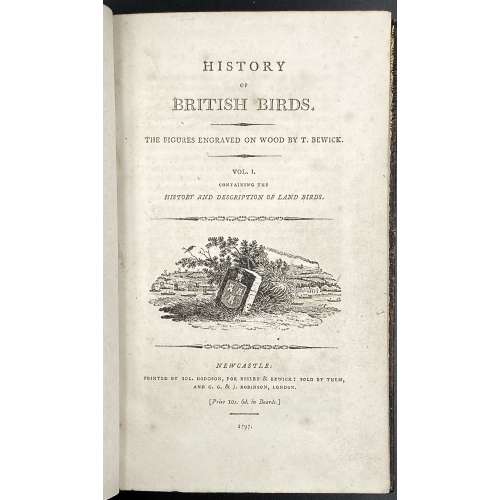 Volume 1: Title: HISTORY | OF | BRITISH BIRDS. | THE FIGURES ENGRAVED ON WOOD BY T. BEWICK. | VOL. I. | CONTAINING THE | HISTORY AND DESCRIPTION OF LAND BIRDS. | [Vignette] | NEWCASTLE: | PRINTED BY SOL. HODGSON, FOR BEILBY & BEWICK : SOLD BY THEM, | AND G. G. & J. ROBINSON, LONDON. | [Price 10s 6d. in Boards] | 1797|| Pagination: [2 blanks], [i, ii] – t.p. / blank, [iii] iv-xxx, [2] – f.t. / blank, [1] 2-335 [336 advert.] [2 blanks]; vignettes on t.p.'s; head- and tail-pieces; publisher's advertisement on final p. of v. 1. Collation: demi 8vo; a-b8, B-Y8; no sigs. A, p. 279 numbered correctly. Woodcuts: 140 descriptions of birds, 117 figures of birds, 91 vignettes, tail-pieces, etc. 1,000 copies printed. Variant B with a vignette at p. 22 printed vertically. Vignette at p. 285 without bars. Volume 2: Title: HISTORY | OF | BRITISH BIRDS. | THE FIGURES ENGRAVED ON WOOD BY T. BEWICK. | VOL. I. | CONTAINING THE | HISTORY AND DESCRIPTION OF WATER BIRDS. | [Vignette] | NEWCASTLE: | PRINTED BY EDWARD WALKER, FOR T. BEWICK : SOLD BY HIM, AND | LONGMAN AND REES, LONDON. | [Price 12s in Boards] | 1804|| Pagination: [2 blanks], [i, ii] – t.p. / blank; [iii] iv-xx, [1] 2-400, [2 blanks]. Collation: Demy 8vo in fours; a2 b-c4, A-3D4; E2, P2, Cc2 insigned. Woodcuts: 144 descriptions of birds, 101 figures of birds, 136 vignettes, tail-pieces, etc. Variant C: Vignette on p. 136 in 1st state, vignettes on pp. 269 and 359 in 2nd state. Binding: speckled full brown calf (restored), contemporary boards ruled in gilt, later spine with raised bands, gilt lettering and florets in compartments, marbled endpapers; 261 woodcut illustrations; printed on wove paper. In both volumes: armorial bookplate of "Clark, Knedlington, Yorks." with the motto "The time will come" on the front pastedown. Size: 21.5 x 14 cm, page: 20.6 x 12.6 cm, demi 8vo. Catalogue raisonné: Hugo (1866): № (99) 94 –120 (108) / pp. 40-58; Roscoe (1953): № 14 a-d, 17 a-d / pp. 46-52 and 65-76. See later edition in this collection: LIB-0860.2015.
Volume 1: Title: HISTORY | OF | BRITISH BIRDS. | THE FIGURES ENGRAVED ON WOOD BY T. BEWICK. | VOL. I. | CONTAINING THE | HISTORY AND DESCRIPTION OF LAND BIRDS. | [Vignette] | NEWCASTLE: | PRINTED BY SOL. HODGSON, FOR BEILBY & BEWICK : SOLD BY THEM, | AND G. G. & J. ROBINSON, LONDON. | [Price 10s 6d. in Boards] | 1797|| Pagination: [2 blanks], [i, ii] – t.p. / blank, [iii] iv-xxx, [2] – f.t. / blank, [1] 2-335 [336 advert.] [2 blanks]; vignettes on t.p.'s; head- and tail-pieces; publisher's advertisement on final p. of v. 1. Collation: demi 8vo; a-b8, B-Y8; no sigs. A, p. 279 numbered correctly. Woodcuts: 140 descriptions of birds, 117 figures of birds, 91 vignettes, tail-pieces, etc. 1,000 copies printed. Variant B with a vignette at p. 22 printed vertically. Vignette at p. 285 without bars. Volume 2: Title: HISTORY | OF | BRITISH BIRDS. | THE FIGURES ENGRAVED ON WOOD BY T. BEWICK. | VOL. I. | CONTAINING THE | HISTORY AND DESCRIPTION OF WATER BIRDS. | [Vignette] | NEWCASTLE: | PRINTED BY EDWARD WALKER, FOR T. BEWICK : SOLD BY HIM, AND | LONGMAN AND REES, LONDON. | [Price 12s in Boards] | 1804|| Pagination: [2 blanks], [i, ii] – t.p. / blank; [iii] iv-xx, [1] 2-400, [2 blanks]. Collation: Demy 8vo in fours; a2 b-c4, A-3D4; E2, P2, Cc2 insigned. Woodcuts: 144 descriptions of birds, 101 figures of birds, 136 vignettes, tail-pieces, etc. Variant C: Vignette on p. 136 in 1st state, vignettes on pp. 269 and 359 in 2nd state. Binding: speckled full brown calf (restored), contemporary boards ruled in gilt, later spine with raised bands, gilt lettering and florets in compartments, marbled endpapers; 261 woodcut illustrations; printed on wove paper. In both volumes: armorial bookplate of "Clark, Knedlington, Yorks." with the motto "The time will come" on the front pastedown. Size: 21.5 x 14 cm, page: 20.6 x 12.6 cm, demi 8vo. Catalogue raisonné: Hugo (1866): № (99) 94 –120 (108) / pp. 40-58; Roscoe (1953): № 14 a-d, 17 a-d / pp. 46-52 and 65-76. See later edition in this collection: LIB-0860.2015. -
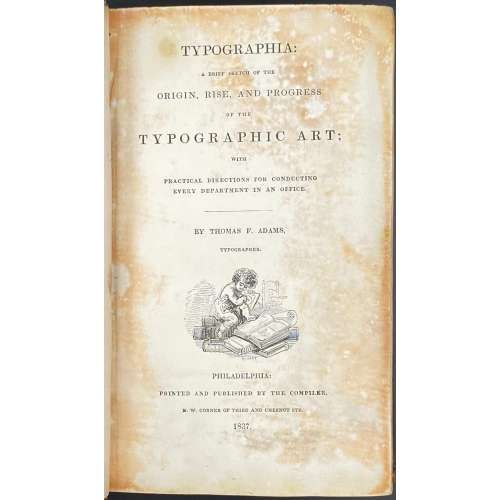 Title: TYPOGRAPHIA : | A BRIEF SKETCH OF THE | ORIGIN, RISE, AND PROGRESS | OF THE | TYPOGRAPHIC ART; | WITH | PRACTICAL DIRECTIONS FOR CONDUCTING | EVERY DEPARTMENT IN AN OFFICE. | BY THOMAS F. ADAMS, TYPOGRAPHER. | {vignette} | PHILADELPHIA: | PRINTED AND PUBLISHED BY THE COMPILER, | N. W. CORNER OF THIRD AND CHESNUT STS. | 1837. || Pagination: Engraved frontispiece w/guard, t.p. / blank, [1-3] 4-372 [8], incl. Index and Directions to binder. Collation: 12mo; 1-31(6). Binding: contemporary full brown speckled calf, flat spine bands with gilt double-fillets, dark brown lettering label. Note: Plagiarism of John Johnson's (British, 1777 – 1848) book Typographia, or, The printers' instructor published in London by Longman, Hurst, Rees, Orme, Brown & Green in 1824. .
Title: TYPOGRAPHIA : | A BRIEF SKETCH OF THE | ORIGIN, RISE, AND PROGRESS | OF THE | TYPOGRAPHIC ART; | WITH | PRACTICAL DIRECTIONS FOR CONDUCTING | EVERY DEPARTMENT IN AN OFFICE. | BY THOMAS F. ADAMS, TYPOGRAPHER. | {vignette} | PHILADELPHIA: | PRINTED AND PUBLISHED BY THE COMPILER, | N. W. CORNER OF THIRD AND CHESNUT STS. | 1837. || Pagination: Engraved frontispiece w/guard, t.p. / blank, [1-3] 4-372 [8], incl. Index and Directions to binder. Collation: 12mo; 1-31(6). Binding: contemporary full brown speckled calf, flat spine bands with gilt double-fillets, dark brown lettering label. Note: Plagiarism of John Johnson's (British, 1777 – 1848) book Typographia, or, The printers' instructor published in London by Longman, Hurst, Rees, Orme, Brown & Green in 1824. . -
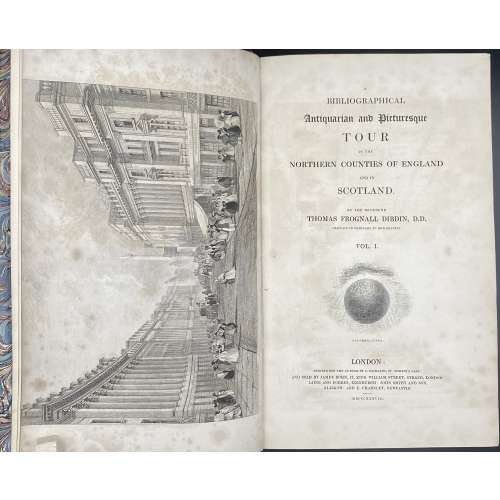 Vol. 1: A | BIBLIOGRAPHICAL | Antiquarian and Picturesque | TOUR | IN THE | NORTHERN COUNTIES OF ENGLAND | AND IN | SCOTLAND. | BY THE REVEREND | THOMAS FROGNALL DIBDIN, D.D. | CHAPLAIN IN ORDINARY TO HER MAJESTY. | VOL. I. |{device} motto: DEI OMNIA PLENA | LONDON: | PRINTED FOR THE AUTHOR BY C. RICHARDS, ST. MARTIN’S LANE : | AND SOLD BY JAMES BOHN, 12 KING WILLIAM STREET, STRAND, LONDON : | LAING AND FORBES, EDINBURGH : JOHN SMITH AND SON, | GLASGOW : AND E. CHARNLEY, NEWCASTLE. | MDCCCXXXVIII.|| Pagination: ffl, frontispiece by W. Douglas after T. M. Richardson, [i-ii] t.p. / blank; [iii-iv] - dedication to Frances Mary Richardson Currer (British, 1785 – 1861) / blank, [v] vi-xv – preface, [i] ii-xxx – supplement & index, [2] – corrections / colophon, [2] list of plates, [2] – contents, [1] 2-436, bfl; 11 plates extraneous to collation (incl. frontis.), lacking one plate (facing p. 213. “Thos. Bridges…”), in-text woodcut vignettes, head- and tailpieces. Collation: 8vo; π8 a-b8 [c2] B-Z8 2A-2E8 2F2. Vol. 2: Similar title but "VOL. II." Pagination: ffl, frontispiece portrait of Hugh Stewart, Aged 84 by Robert Bell after Alison (nothing known); [2] – t.p. / blank, [2] – contents / cont., [437-8] f.t. / blank [439] 440-1090, bfl; 453/4 misprinted 449/50; lacking list of subscribers. Collation: 8vo; π2 [2F3-2F6] 2G-2Z8 3A-3Z8. Binding: By J. Leighton, Brewer Street. Later half dark brown morocco over marbled boards, raised bands with gilt fillets, gilt titling and fillets in compartments, all edges gilt, marbled endpapers. Edition: 1st edition of Dibdin’s last major work and the only edition of this title. Size: 24.5 x 15.5 cm Provenance: Lord Ronald Gower (British, 1845 – 1916); Frank Hird (British, 1873 – 1937). Catalogue raisonné: Jackson 89; Windle & Pippin A65, pp. 179–188 [LIB-2669.2021]. Artists: Abraham, [I.] Frederic Henry (British, 1790 – 1845) Carmichael, James John Wilson (British, 1800 – 1868) Geikie, Walter (British, 1795 – 1837) Harraden, Richard Bankes (British, 1778 – 1862) Hill, David Octavius (British, 1802 –1870) McLea, John Watson (British, fl.1832-1861) Nixon, James Henry (British, b. c. 1808) Reynolds, Sir Joshua (British, 1723 – 1792) Richardson, Thomas Miles (British, 1784 – 1848) Scott, J. (British, fl. 19th c.) Wilkinson, T. M. (British, fl. 19th c.) Engravers: Aikman, Alison [spouse of George Aikman?] (British, 1788 – 1865) Bell, Robert Charles (British, 1806 – 1872) Byfield, Mary (British, 1794/5 – 1871) Douglas, William (British, 1780 – 1832) Harraden, F. (British, fl. 1838) Horsburgh, John (British, 1791 –1869) Johnstone, John (British, fl. 1835 – ) Leith & Smith, Lithogrs (Edinburgh) Lizars, William Home (British, 1788 – 1859) Miller, William (British, 1796 – 1882) Penny, William (British, fl. 19th c.) Prior, Thomas Abiel (British, 1809 – 1886) Robinson, H. (British, fl. 19th c.) Smith, Charles John (British, 1803 – 1838) Thomson, James (British, 1788 – 1850)
Vol. 1: A | BIBLIOGRAPHICAL | Antiquarian and Picturesque | TOUR | IN THE | NORTHERN COUNTIES OF ENGLAND | AND IN | SCOTLAND. | BY THE REVEREND | THOMAS FROGNALL DIBDIN, D.D. | CHAPLAIN IN ORDINARY TO HER MAJESTY. | VOL. I. |{device} motto: DEI OMNIA PLENA | LONDON: | PRINTED FOR THE AUTHOR BY C. RICHARDS, ST. MARTIN’S LANE : | AND SOLD BY JAMES BOHN, 12 KING WILLIAM STREET, STRAND, LONDON : | LAING AND FORBES, EDINBURGH : JOHN SMITH AND SON, | GLASGOW : AND E. CHARNLEY, NEWCASTLE. | MDCCCXXXVIII.|| Pagination: ffl, frontispiece by W. Douglas after T. M. Richardson, [i-ii] t.p. / blank; [iii-iv] - dedication to Frances Mary Richardson Currer (British, 1785 – 1861) / blank, [v] vi-xv – preface, [i] ii-xxx – supplement & index, [2] – corrections / colophon, [2] list of plates, [2] – contents, [1] 2-436, bfl; 11 plates extraneous to collation (incl. frontis.), lacking one plate (facing p. 213. “Thos. Bridges…”), in-text woodcut vignettes, head- and tailpieces. Collation: 8vo; π8 a-b8 [c2] B-Z8 2A-2E8 2F2. Vol. 2: Similar title but "VOL. II." Pagination: ffl, frontispiece portrait of Hugh Stewart, Aged 84 by Robert Bell after Alison (nothing known); [2] – t.p. / blank, [2] – contents / cont., [437-8] f.t. / blank [439] 440-1090, bfl; 453/4 misprinted 449/50; lacking list of subscribers. Collation: 8vo; π2 [2F3-2F6] 2G-2Z8 3A-3Z8. Binding: By J. Leighton, Brewer Street. Later half dark brown morocco over marbled boards, raised bands with gilt fillets, gilt titling and fillets in compartments, all edges gilt, marbled endpapers. Edition: 1st edition of Dibdin’s last major work and the only edition of this title. Size: 24.5 x 15.5 cm Provenance: Lord Ronald Gower (British, 1845 – 1916); Frank Hird (British, 1873 – 1937). Catalogue raisonné: Jackson 89; Windle & Pippin A65, pp. 179–188 [LIB-2669.2021]. Artists: Abraham, [I.] Frederic Henry (British, 1790 – 1845) Carmichael, James John Wilson (British, 1800 – 1868) Geikie, Walter (British, 1795 – 1837) Harraden, Richard Bankes (British, 1778 – 1862) Hill, David Octavius (British, 1802 –1870) McLea, John Watson (British, fl.1832-1861) Nixon, James Henry (British, b. c. 1808) Reynolds, Sir Joshua (British, 1723 – 1792) Richardson, Thomas Miles (British, 1784 – 1848) Scott, J. (British, fl. 19th c.) Wilkinson, T. M. (British, fl. 19th c.) Engravers: Aikman, Alison [spouse of George Aikman?] (British, 1788 – 1865) Bell, Robert Charles (British, 1806 – 1872) Byfield, Mary (British, 1794/5 – 1871) Douglas, William (British, 1780 – 1832) Harraden, F. (British, fl. 1838) Horsburgh, John (British, 1791 –1869) Johnstone, John (British, fl. 1835 – ) Leith & Smith, Lithogrs (Edinburgh) Lizars, William Home (British, 1788 – 1859) Miller, William (British, 1796 – 1882) Penny, William (British, fl. 19th c.) Prior, Thomas Abiel (British, 1809 – 1886) Robinson, H. (British, fl. 19th c.) Smith, Charles John (British, 1803 – 1838) Thomson, James (British, 1788 – 1850) -
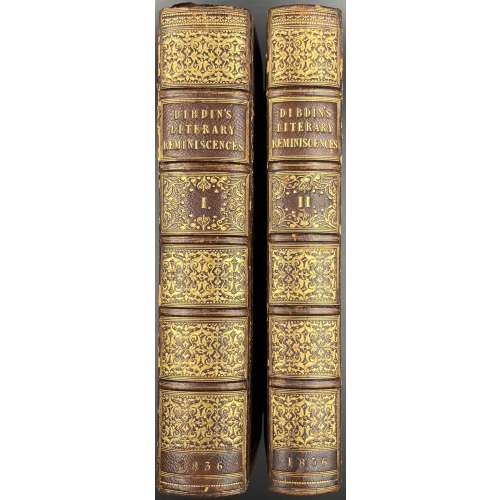 Two volumes uniformly bound by J. Mackenzie, in brown straight-grain morocco, boards with 7 gilt fillet border, fleuron corners, spine with raised bands, gilt in compartments, gilt-lettered DIBDIN’S | LITERARY | REMINISCENCES | I (or) II | 1836. All margins gilt, cream endpapers, armorial bookplate of William Henry Rossington to the front pastedown. Vol. 1: Title page: REMINISCENCES | OF | A LITERARY LIFE; | BY THE REVEREND | THOS. FROGNALL DIBDIN, D.D. | {vignette} | {one line citation | Richard de Bury} | LONDON: | JOHN MAJOR, 71, GREAT RUSSELL-STREET, | BLOOMSBURY. | MDCCCXXXVI. || Pagination: [4] two blank leaves, [i-v] vi-xxxii [4] list of plates, corrections, [1] 2-556 [4] two blank leaves. Collation: 8vo; [a]8 b8 [c]2, B-Z8, AA-MM8 NN6, 5 plates (incl. frontis. portrait by James Posselwhite after George Richmond) extraneous to collation, and a few vignettes in text. Vol. 2: Title page: REMINISCENCES | OF | A LITERARY LIFE; | WITH ANECDOTES OF BOOKS, | AND OF | BOOK COLLECTORS: | BY THE REVEREND | THOS. FROGNALL DIBDIN, D.D. | PART THE SECOND. | LONDON: | JOHN MAJOR, 71, GREAT RUSSELL-STREET, | BLOOMSBURY. | MDCCCXXXVI. || Pagination: [4] two blank leaves, [2] title/blank, 557-982, [1-3] 4-44 index, [4] two blank leaves. Collation: 8vo; [NN]2 OO-ZZ8 3A-3Q8 3R3, B-C8 D4, 5 plates (incl. frontis. “The Library, Eshton Hall”) extraneous to collation, and a few vignettes in text. Catalogue raisonné: Windle, Pippin (1999): A62 / pp. 171-177. Contributors: Author: Thomas Frognall Dibdin (British, 1776 – 1847) Artists: George Richmond (British, 1809 – 1896); Mary Dawson Turner [neé Mary Palgrave] (British, 1774 – 1850); Frederick Mackenzie (British, 1788? – 1854); C. J. Stewart (British, fl. 1830s). Copper engravers: James Posselwhite (British, 1798-1884); Philip Audinet (British, 1766 – 1837); William Henry Worthington. (British, c. 1790 – after 1839); Samuel Rawle (British, 1771 – 1860); Samuel Freeman (British, 1773 – 1857); James Thomson (British, 1788–1850). Wood engravings by John Byfield (British, 1788-1841) and his sister Mary Byfield (British, 1795 – 1871). Printer: William Wilcockson, Rolls Buildings, Fetter Lane. Publisher: John Major (British, 1782 – 1849) Binder: John Mackenzie (British, 1788 – c.1850) – held the office of bookbinder to both King George IV and King William IV. Bookplate: Colonel William Henry Rossington (American, 1848 – 1908)
Two volumes uniformly bound by J. Mackenzie, in brown straight-grain morocco, boards with 7 gilt fillet border, fleuron corners, spine with raised bands, gilt in compartments, gilt-lettered DIBDIN’S | LITERARY | REMINISCENCES | I (or) II | 1836. All margins gilt, cream endpapers, armorial bookplate of William Henry Rossington to the front pastedown. Vol. 1: Title page: REMINISCENCES | OF | A LITERARY LIFE; | BY THE REVEREND | THOS. FROGNALL DIBDIN, D.D. | {vignette} | {one line citation | Richard de Bury} | LONDON: | JOHN MAJOR, 71, GREAT RUSSELL-STREET, | BLOOMSBURY. | MDCCCXXXVI. || Pagination: [4] two blank leaves, [i-v] vi-xxxii [4] list of plates, corrections, [1] 2-556 [4] two blank leaves. Collation: 8vo; [a]8 b8 [c]2, B-Z8, AA-MM8 NN6, 5 plates (incl. frontis. portrait by James Posselwhite after George Richmond) extraneous to collation, and a few vignettes in text. Vol. 2: Title page: REMINISCENCES | OF | A LITERARY LIFE; | WITH ANECDOTES OF BOOKS, | AND OF | BOOK COLLECTORS: | BY THE REVEREND | THOS. FROGNALL DIBDIN, D.D. | PART THE SECOND. | LONDON: | JOHN MAJOR, 71, GREAT RUSSELL-STREET, | BLOOMSBURY. | MDCCCXXXVI. || Pagination: [4] two blank leaves, [2] title/blank, 557-982, [1-3] 4-44 index, [4] two blank leaves. Collation: 8vo; [NN]2 OO-ZZ8 3A-3Q8 3R3, B-C8 D4, 5 plates (incl. frontis. “The Library, Eshton Hall”) extraneous to collation, and a few vignettes in text. Catalogue raisonné: Windle, Pippin (1999): A62 / pp. 171-177. Contributors: Author: Thomas Frognall Dibdin (British, 1776 – 1847) Artists: George Richmond (British, 1809 – 1896); Mary Dawson Turner [neé Mary Palgrave] (British, 1774 – 1850); Frederick Mackenzie (British, 1788? – 1854); C. J. Stewart (British, fl. 1830s). Copper engravers: James Posselwhite (British, 1798-1884); Philip Audinet (British, 1766 – 1837); William Henry Worthington. (British, c. 1790 – after 1839); Samuel Rawle (British, 1771 – 1860); Samuel Freeman (British, 1773 – 1857); James Thomson (British, 1788–1850). Wood engravings by John Byfield (British, 1788-1841) and his sister Mary Byfield (British, 1795 – 1871). Printer: William Wilcockson, Rolls Buildings, Fetter Lane. Publisher: John Major (British, 1782 – 1849) Binder: John Mackenzie (British, 1788 – c.1850) – held the office of bookbinder to both King George IV and King William IV. Bookplate: Colonel William Henry Rossington (American, 1848 – 1908) -
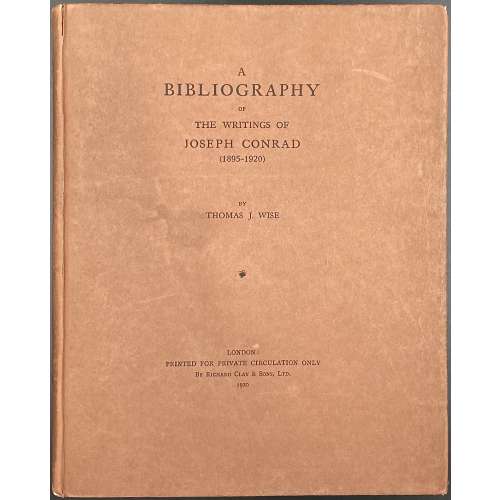 Title page: A | BIBLIOGRAPHY | OF | THE WRITINGS OF | JOSEPH CONRAD (1895–1920) | BY THOMAS J. WISE | ❦ | LONDON: | PRINTED FOR PRIVATE CIRCULATION ONLY | By Richard Clay & Sons, Ltd. | 1920 || Pagination: [i-viii] ix-xiii [xiv-xvi], [1, 2] 3-105 [106-112], frontispiece with tissue guard in collation; 128 pages total. Collation: 8vo; [A]-H8, 64 leaves total. Binding: 22.5 x 18 cm; terracotta paper boards, black lettering to front and spine; uncut. The device on the recto of the last leaf inscribed: The Ashley library. Privately printed. 1920. Insert: ALS from Thomas J. Wise dated 22/3/21 on watermarked paper (King of Kent | Extra Fine) with letterhead “Kirkstead”, 25 Heath Drive, Hampstead, N.W.3. The letter is a response to a request for two copies of Volume II of Wise’s Swinburne bibliography, which Wise promises to supply the next day to Stevens & Brown (founded in 1864, Literary and Fine Arts Agents). Limitation: 150 copies, private printing. Contributors: Joseph Conrad [Józef Teodor Konrad Korzeniowski] (British-Polish, 1857 – 1924) Wise, Thomas James (British, 1859 – 1937) – compiler, bibliographer. R. Clay & Sons Ltd. (London); Clay, Richard (British, 1789 – 1877) – publisher. The Ashley Library (London) – printer.
Title page: A | BIBLIOGRAPHY | OF | THE WRITINGS OF | JOSEPH CONRAD (1895–1920) | BY THOMAS J. WISE | ❦ | LONDON: | PRINTED FOR PRIVATE CIRCULATION ONLY | By Richard Clay & Sons, Ltd. | 1920 || Pagination: [i-viii] ix-xiii [xiv-xvi], [1, 2] 3-105 [106-112], frontispiece with tissue guard in collation; 128 pages total. Collation: 8vo; [A]-H8, 64 leaves total. Binding: 22.5 x 18 cm; terracotta paper boards, black lettering to front and spine; uncut. The device on the recto of the last leaf inscribed: The Ashley library. Privately printed. 1920. Insert: ALS from Thomas J. Wise dated 22/3/21 on watermarked paper (King of Kent | Extra Fine) with letterhead “Kirkstead”, 25 Heath Drive, Hampstead, N.W.3. The letter is a response to a request for two copies of Volume II of Wise’s Swinburne bibliography, which Wise promises to supply the next day to Stevens & Brown (founded in 1864, Literary and Fine Arts Agents). Limitation: 150 copies, private printing. Contributors: Joseph Conrad [Józef Teodor Konrad Korzeniowski] (British-Polish, 1857 – 1924) Wise, Thomas James (British, 1859 – 1937) – compiler, bibliographer. R. Clay & Sons Ltd. (London); Clay, Richard (British, 1789 – 1877) – publisher. The Ashley Library (London) – printer. -
 Title-page: AMINTA | FAVOLA BOSCARECCIA | DI | TORQUATO TASSO | CON | LE ANNOTATIONI | D'EGIDIO MENAGIO | ACCADEMICO | DELLA CRVSCA• | {woodcut vignette} | IN PARIGI| Presso AGOSTINO Cvrbe`, nella Galeria del Palazzo, | all’ insegna della Palma. |—| M. DC. LV. || Collation: 4to; ā4 ē4 ī4 A2 B2 C-V4 Y-Z4 2A1,2 X4 2A3,4 2B-2Z4, 3A-3B4, total number of leaves = 200. Note: O2, 2K3, 2V3 2X3 2Y3, and 3B3 – unsigned, 2Z3 signed 2Z2 (Zzij), quire X (pp. 145-152) bound between 2A2 (p. 172) and 2A3 (p. 173); illustrated throughout with woodcut head- and tailpieces and initials, Atto Primo has copperplate engraved historiated initial and a headpiece signed “F. C. in. — I. B. fe.” “I. B.” was a monogram of engraver Giulio Bonasone (Italian, c. 1498 – after 1574). Pagination: [2] – t.p. / blank, [8] – dedication, i-xviii, [4], 1-341 [342-368]; total number of pages = 400. Binding: 22.3 x 18 cm, 19th-century quarter morocco over marbled boards, spine with raised bands and gilt lettering, rebacked, additional blank flyleaves at front and back, marbled endpapers and all edges. Bookplate to front pastedown: “The Robin Collection”. Verso front flyleaf stamped “RESTORED BY MACDONALD CO. | NORWALK. CONN. Provenance: The Robin Collection. Contributors: Torquato Tasso (Italian, 1544 –1595) – author. Gilles Ménage (French, 1613 – 1692) – author. Antoine Vitré (French, 1595 – 1674) – printer. Augustin Courbé (French, fl. c. 1625 – 1660) – publisher. Marie-Madeleine Pioche de La Vergne, comtesse de La Fayette (French, 1634 – 1693) – dedicatee.
Title-page: AMINTA | FAVOLA BOSCARECCIA | DI | TORQUATO TASSO | CON | LE ANNOTATIONI | D'EGIDIO MENAGIO | ACCADEMICO | DELLA CRVSCA• | {woodcut vignette} | IN PARIGI| Presso AGOSTINO Cvrbe`, nella Galeria del Palazzo, | all’ insegna della Palma. |—| M. DC. LV. || Collation: 4to; ā4 ē4 ī4 A2 B2 C-V4 Y-Z4 2A1,2 X4 2A3,4 2B-2Z4, 3A-3B4, total number of leaves = 200. Note: O2, 2K3, 2V3 2X3 2Y3, and 3B3 – unsigned, 2Z3 signed 2Z2 (Zzij), quire X (pp. 145-152) bound between 2A2 (p. 172) and 2A3 (p. 173); illustrated throughout with woodcut head- and tailpieces and initials, Atto Primo has copperplate engraved historiated initial and a headpiece signed “F. C. in. — I. B. fe.” “I. B.” was a monogram of engraver Giulio Bonasone (Italian, c. 1498 – after 1574). Pagination: [2] – t.p. / blank, [8] – dedication, i-xviii, [4], 1-341 [342-368]; total number of pages = 400. Binding: 22.3 x 18 cm, 19th-century quarter morocco over marbled boards, spine with raised bands and gilt lettering, rebacked, additional blank flyleaves at front and back, marbled endpapers and all edges. Bookplate to front pastedown: “The Robin Collection”. Verso front flyleaf stamped “RESTORED BY MACDONALD CO. | NORWALK. CONN. Provenance: The Robin Collection. Contributors: Torquato Tasso (Italian, 1544 –1595) – author. Gilles Ménage (French, 1613 – 1692) – author. Antoine Vitré (French, 1595 – 1674) – printer. Augustin Courbé (French, fl. c. 1625 – 1660) – publisher. Marie-Madeleine Pioche de La Vergne, comtesse de La Fayette (French, 1634 – 1693) – dedicatee. -
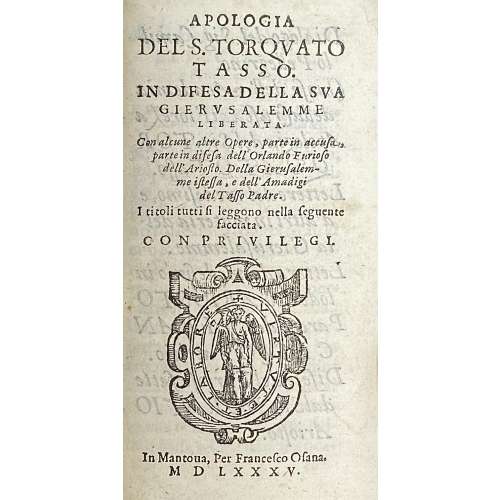 Title-page: APOLOGIA | DEL S. TORQVATO | TASSO. | IN DIFESA DELLA SVA | GIERVSALEMME | LIBERATA. | Con alcune Opere, partien in accusa, | partein difesa dell Orlando Furioso | dell’Ariosto. | Della Gierusalem- | me istessa , e dell’Amadigi | del Tasso Padre. | I titoli tutti si leggono nella feguente | facciata. | con privilegi. | {publisher’s device} | In Mantoua, Per Francesco Osana. | M D LXXXV. || 1st blank π1, [a]-a8; (9 leaves, 18 pp., unpaginated) Divisional t.p. (1): DE GLI | ACCADEMICI | DELLA CRVSCA | DIFESA DELL’ ORLANDO | FVRIOSO DELL’ ARIOSTO | Contra’l Dialogo dell’Epica | poesia di Camillo | Pellegrino. | Stacciata prima. | {woodcut} ||; A-E12 [2]A1 (61 leaves, 122 pp., unpaginated). Divisional t.p. (2): APOLOGIA | DEL S. TORQVATO | TASSO. | IN DIFESA DELLA SVA | GIERVSALEMME | LIBERATA. | {publisher’s device} | IN MANTOVA, |—| Per Francesco Osanna. | MDLXXXV. || [2]A11 2B-[2]I12 [2]K4, pp. [2] 3-219 [3] (111 leaves, 222 pages). Divisional t.p. (3): DELL’ | INFARINATO | ACADEMICO | DELLA CRVSCA … etc. | MDLXXXV. | Con licenza de’ Superiori. || [3]A-[3]G12, pp. [2] 3-164, 163 (i.e. 165) [3] (84 leaves, 168 pages). Divisional t.p. (4): RIPOSTA | DEL S. TORQVATO | TASSO, | ALLA LETTERA | DI BASTIAN ROSSI, …etc. | MDLXXXV. | Con licenza de’ Superiori. || [4]A-[4]E12 F8, ([4]B3 i.e. [4]A3), pp. [2] 3-135 [1] (68 leaves, 136 pages). Divisional t.p. (5): DISCORSO | IN TORNO | A’CONTRASTI, | CHE SI FANNO | SOPRA… ect. | M D LXXXVI. || [5]A-[5]D12 E4, pp. [2]3-67, 66 (i.e. 68), 92 (69), 70-73 (70-73), 94 (74), 95 (75), 76, 77, 98-115 (78-95), 112 (96), 97-100, [4] (52 leaves, 104 pages). Divisional t.p. (6): PARERE | DEL SIGNOR | TORQVATO | TASSO. | SOPRA IL DISCORSO | del Signor Horatio Lom- | bardello intorno a’ | contrasti,&c. … etc. | M D LXXXVI. || [6]A12 [6]B6 (incl. last blank), pp. [1-5] 6-33 [3] (18 leaves, 36 pages). Collation: 12mo; π1, a8, A-E12, [2]A-[2]I12 [2]K4, [3]A-[3]G12, [4]A-[4]E12 F8, [5]A-[5]D12 E4, [6]A12 [6]B6 (incl. last blank), total 403 leaves, 806 pages, in-text woodcut head- and tailpieces, and initials. Binding: 14.4 x 9 cm, 19th-century quarter calf over marbled boards, raised bands, gilt-bordered compartments, gilt lettering, three flyleaves at the front and back, "The Robin Collection" bookplate to front pastedown. Provenance: The Robin Collection. Contributors: Torquato Tasso (Italian, 1544 –1595) – author. Orazio Ariosto (Italian, 1555 – 1593) – author. Ludovico Ariosto (Italian, 1474 – 1533) – author. Camillo Pellegrino (Italian, 1527-1603) – author. Francesco Osanna [Osana] (Italian, fl. 1549 – 1608) – printer, publisher.
Title-page: APOLOGIA | DEL S. TORQVATO | TASSO. | IN DIFESA DELLA SVA | GIERVSALEMME | LIBERATA. | Con alcune Opere, partien in accusa, | partein difesa dell Orlando Furioso | dell’Ariosto. | Della Gierusalem- | me istessa , e dell’Amadigi | del Tasso Padre. | I titoli tutti si leggono nella feguente | facciata. | con privilegi. | {publisher’s device} | In Mantoua, Per Francesco Osana. | M D LXXXV. || 1st blank π1, [a]-a8; (9 leaves, 18 pp., unpaginated) Divisional t.p. (1): DE GLI | ACCADEMICI | DELLA CRVSCA | DIFESA DELL’ ORLANDO | FVRIOSO DELL’ ARIOSTO | Contra’l Dialogo dell’Epica | poesia di Camillo | Pellegrino. | Stacciata prima. | {woodcut} ||; A-E12 [2]A1 (61 leaves, 122 pp., unpaginated). Divisional t.p. (2): APOLOGIA | DEL S. TORQVATO | TASSO. | IN DIFESA DELLA SVA | GIERVSALEMME | LIBERATA. | {publisher’s device} | IN MANTOVA, |—| Per Francesco Osanna. | MDLXXXV. || [2]A11 2B-[2]I12 [2]K4, pp. [2] 3-219 [3] (111 leaves, 222 pages). Divisional t.p. (3): DELL’ | INFARINATO | ACADEMICO | DELLA CRVSCA … etc. | MDLXXXV. | Con licenza de’ Superiori. || [3]A-[3]G12, pp. [2] 3-164, 163 (i.e. 165) [3] (84 leaves, 168 pages). Divisional t.p. (4): RIPOSTA | DEL S. TORQVATO | TASSO, | ALLA LETTERA | DI BASTIAN ROSSI, …etc. | MDLXXXV. | Con licenza de’ Superiori. || [4]A-[4]E12 F8, ([4]B3 i.e. [4]A3), pp. [2] 3-135 [1] (68 leaves, 136 pages). Divisional t.p. (5): DISCORSO | IN TORNO | A’CONTRASTI, | CHE SI FANNO | SOPRA… ect. | M D LXXXVI. || [5]A-[5]D12 E4, pp. [2]3-67, 66 (i.e. 68), 92 (69), 70-73 (70-73), 94 (74), 95 (75), 76, 77, 98-115 (78-95), 112 (96), 97-100, [4] (52 leaves, 104 pages). Divisional t.p. (6): PARERE | DEL SIGNOR | TORQVATO | TASSO. | SOPRA IL DISCORSO | del Signor Horatio Lom- | bardello intorno a’ | contrasti,&c. … etc. | M D LXXXVI. || [6]A12 [6]B6 (incl. last blank), pp. [1-5] 6-33 [3] (18 leaves, 36 pages). Collation: 12mo; π1, a8, A-E12, [2]A-[2]I12 [2]K4, [3]A-[3]G12, [4]A-[4]E12 F8, [5]A-[5]D12 E4, [6]A12 [6]B6 (incl. last blank), total 403 leaves, 806 pages, in-text woodcut head- and tailpieces, and initials. Binding: 14.4 x 9 cm, 19th-century quarter calf over marbled boards, raised bands, gilt-bordered compartments, gilt lettering, three flyleaves at the front and back, "The Robin Collection" bookplate to front pastedown. Provenance: The Robin Collection. Contributors: Torquato Tasso (Italian, 1544 –1595) – author. Orazio Ariosto (Italian, 1555 – 1593) – author. Ludovico Ariosto (Italian, 1474 – 1533) – author. Camillo Pellegrino (Italian, 1527-1603) – author. Francesco Osanna [Osana] (Italian, fl. 1549 – 1608) – printer, publisher. -
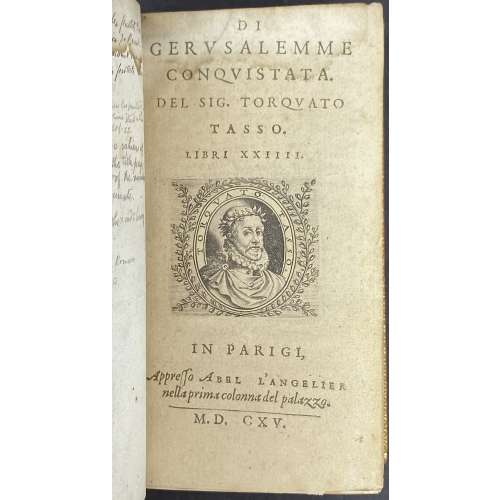 Title-page (1): DI | GERVSALEMME | CONQVISTATA. | DEL SIG. TORQVATO | TASSO. | LIBRI XXIIII. | {engraved portrait of Torquato Tasso in lettered oval medallion surrounded with laurel branches} | IN PARIGI, | Appresso Abel L’ANGELIER | nella prima Colonna del palazzo. | M.D. CXV. || Title-page (2): DI | GERVSALEMME | CONQVISTATA. | DEL SIG. TORQVATO | TASSO. | LIBRI XXIIII. | ALL’ ILL. MO ET REV. MO| SIG. RE| IL SIGNOR. | CINTHIO ALDOBRANDINI | Card. Di San Giorgio. | Appresso Abel L’ANGELIERI | nella prima Colonna del palazzo. | M.D. LCXV. || Collation: 1st blank leaf with an extensive pencil MS in French and English (unsigned), 1st t.p. / blank (unsigned), 2nd t.p. / blank [ai] (unsigned), Dedication by Angelo Ingegneri dated 10-NOV-1592 (ã2-ã5), dedication by Torquato Tasso and Aux Lecteur by Abel L’Angelier ã5[i.e. 6]-[ã9]; 12mo: π12, A-Z12, 2A-2Q12 (2Q11 woodcut / blank, 2Q12 blank), total 480 leaves, with woodcut head- and tailpieces, historiated initials. Note: leaves D6, M3, M6, and N3 unsigned; leave E2 signed for F2, E4 – for F4, Z – for Z5, and A – for Aa. Pagination: 12 prelims unpag., 1-361, each leaf paginated as one page) [2]; with a lot of mispaginations: shall be 1-468, but after p.291 follows 278 (for 292), then 193 for 293, etc. Binding: 14.5 x 8.5 cm, 20th-century tan morocco by Zaehnsdorf (signed in gilt), gilt fleurons in corners and in compartments, raised bands, titles on spine, gilt dentelles, marbled endpapers plus 6 fep at the front (one with pasted clipping “A PARIS, Chez Fetil, Libraire, rue des Cor-| deliers, près celle de Condé, au | Parnasse Italien”, and 2 at the end. What connection has the 18th-century publisher with this edition remains unclear. “The Robin Collection” bookplate to front pastedown. Edges sprinkled red. Occasional damp staining to top margins. There is controversy regarding the year of this publication. It could be 1615 (MDCXV), however, both the publisher and the dedicatee were dead this year. Dedication by the publisher dated 1592. We agree with those scholars who suggest that MDCXV and MDLCXV were misprinted for MDXCV (1595). Provenance: The Robin Collection. Contributors: Torquato Tasso (Italian, 1544 –1595) – author. Angelo Ingegneri (Italian, 1550 – 1613) – author. Abel L'Angelier (French, 1553? – 1610) – printer, publisher. Cinzio Aldobrandini (Italian, 1551 – 1610) – dedicatee.
Title-page (1): DI | GERVSALEMME | CONQVISTATA. | DEL SIG. TORQVATO | TASSO. | LIBRI XXIIII. | {engraved portrait of Torquato Tasso in lettered oval medallion surrounded with laurel branches} | IN PARIGI, | Appresso Abel L’ANGELIER | nella prima Colonna del palazzo. | M.D. CXV. || Title-page (2): DI | GERVSALEMME | CONQVISTATA. | DEL SIG. TORQVATO | TASSO. | LIBRI XXIIII. | ALL’ ILL. MO ET REV. MO| SIG. RE| IL SIGNOR. | CINTHIO ALDOBRANDINI | Card. Di San Giorgio. | Appresso Abel L’ANGELIERI | nella prima Colonna del palazzo. | M.D. LCXV. || Collation: 1st blank leaf with an extensive pencil MS in French and English (unsigned), 1st t.p. / blank (unsigned), 2nd t.p. / blank [ai] (unsigned), Dedication by Angelo Ingegneri dated 10-NOV-1592 (ã2-ã5), dedication by Torquato Tasso and Aux Lecteur by Abel L’Angelier ã5[i.e. 6]-[ã9]; 12mo: π12, A-Z12, 2A-2Q12 (2Q11 woodcut / blank, 2Q12 blank), total 480 leaves, with woodcut head- and tailpieces, historiated initials. Note: leaves D6, M3, M6, and N3 unsigned; leave E2 signed for F2, E4 – for F4, Z – for Z5, and A – for Aa. Pagination: 12 prelims unpag., 1-361, each leaf paginated as one page) [2]; with a lot of mispaginations: shall be 1-468, but after p.291 follows 278 (for 292), then 193 for 293, etc. Binding: 14.5 x 8.5 cm, 20th-century tan morocco by Zaehnsdorf (signed in gilt), gilt fleurons in corners and in compartments, raised bands, titles on spine, gilt dentelles, marbled endpapers plus 6 fep at the front (one with pasted clipping “A PARIS, Chez Fetil, Libraire, rue des Cor-| deliers, près celle de Condé, au | Parnasse Italien”, and 2 at the end. What connection has the 18th-century publisher with this edition remains unclear. “The Robin Collection” bookplate to front pastedown. Edges sprinkled red. Occasional damp staining to top margins. There is controversy regarding the year of this publication. It could be 1615 (MDCXV), however, both the publisher and the dedicatee were dead this year. Dedication by the publisher dated 1592. We agree with those scholars who suggest that MDCXV and MDLCXV were misprinted for MDXCV (1595). Provenance: The Robin Collection. Contributors: Torquato Tasso (Italian, 1544 –1595) – author. Angelo Ingegneri (Italian, 1550 – 1613) – author. Abel L'Angelier (French, 1553? – 1610) – printer, publisher. Cinzio Aldobrandini (Italian, 1551 – 1610) – dedicatee. -
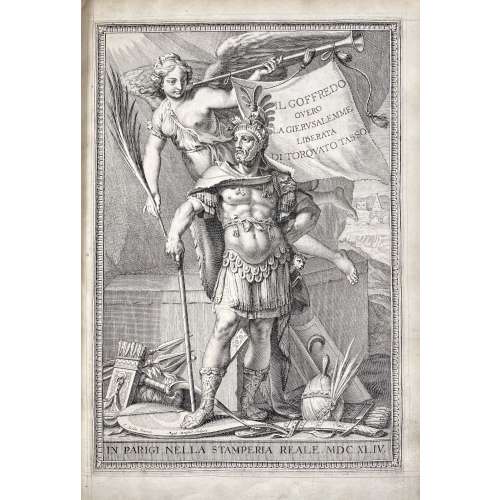 Title page: IL | GOFFREDO | OVERO | LA | GIERUSALEMME | LIBERATA | DI TORQUATO TASSO. || Engraved title: On the banner: IL GOFFREDO | OVERO | LA GIERUSALEMME | LIBERATA | DI TORQUATO TASSO ||; under the image, within frame: IN PARIGI NELLA STAMPERIA REALE MDC XLIV. Signed: J. Stella Invenit — Ægid Rousselet Sculpsit (with tall “s”) || Collation: 2 blank leaves with donation ink inscription to recto of the 1st: “Ex Dono Patruelis Do Roberto Willughby” [i.e. Robert Willoughby]; t.p. / blank, engraved t.p. by Gilles Rousselet after Jacques Stella / blank, “Allegoria dell poema” 4 leaves, 1st two leaves signed iij and iiij, respectively; π6 A-Z4 Aa-Zz4 Aaa-Rrr4, 2 blank leaves at the end; text paginated from 1 to 502 [2] (p. 503 tailpiece, p. 504 blank); a printable area marked with vertical and horizontal double lines; total: 252 leaves of text (504 pages), 6 prelims and 4 blanks. Illustrated throughout with head- and tailpieces, and historiated initials. Binding: 18th-century red crushed morocco, triple-fillet gilt border, triple-fillet gilt frame, panel with gilt lozenge centrepiece, lozenges at corners, marbled endpapers, AEG, crudely rebacked retaining original spine with raised bands, gilt in compartments, crimson label with gilt lettering; The Robin Collection bookplate to front pastedown. Provenance: The Robin Collection; Robert Willoughby family. Contributors: Torquato Tasso (Italian, 1544 –1595) – author. Jacques Stella (French, 1596 – 1657) – artist. Gilles [Aegidius] Rousselet (French, 1610 – 1686) – engraver.
Title page: IL | GOFFREDO | OVERO | LA | GIERUSALEMME | LIBERATA | DI TORQUATO TASSO. || Engraved title: On the banner: IL GOFFREDO | OVERO | LA GIERUSALEMME | LIBERATA | DI TORQUATO TASSO ||; under the image, within frame: IN PARIGI NELLA STAMPERIA REALE MDC XLIV. Signed: J. Stella Invenit — Ægid Rousselet Sculpsit (with tall “s”) || Collation: 2 blank leaves with donation ink inscription to recto of the 1st: “Ex Dono Patruelis Do Roberto Willughby” [i.e. Robert Willoughby]; t.p. / blank, engraved t.p. by Gilles Rousselet after Jacques Stella / blank, “Allegoria dell poema” 4 leaves, 1st two leaves signed iij and iiij, respectively; π6 A-Z4 Aa-Zz4 Aaa-Rrr4, 2 blank leaves at the end; text paginated from 1 to 502 [2] (p. 503 tailpiece, p. 504 blank); a printable area marked with vertical and horizontal double lines; total: 252 leaves of text (504 pages), 6 prelims and 4 blanks. Illustrated throughout with head- and tailpieces, and historiated initials. Binding: 18th-century red crushed morocco, triple-fillet gilt border, triple-fillet gilt frame, panel with gilt lozenge centrepiece, lozenges at corners, marbled endpapers, AEG, crudely rebacked retaining original spine with raised bands, gilt in compartments, crimson label with gilt lettering; The Robin Collection bookplate to front pastedown. Provenance: The Robin Collection; Robert Willoughby family. Contributors: Torquato Tasso (Italian, 1544 –1595) – author. Jacques Stella (French, 1596 – 1657) – artist. Gilles [Aegidius] Rousselet (French, 1610 – 1686) – engraver. -
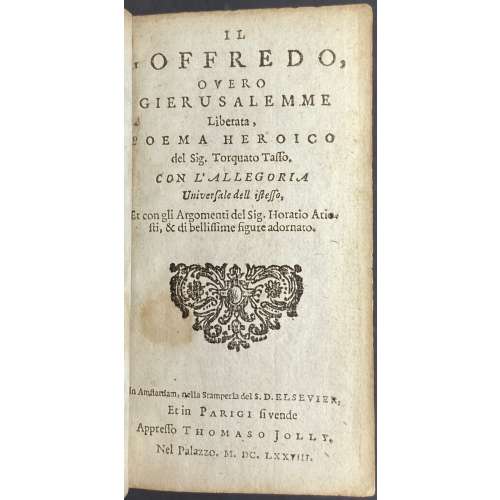 Vol. 1: Engraved t.p.: An architectural setting with flags and arms, and sitting male and female figures in armour, perhaps representing Tancredi and Clorinda, with lettering above their heads: “GIERVSA– | LEMME | LIBERATA”. Title-page: IL | GOFFREDO, | OVERO | GIERUSALEMME | Liberata , | POEMA HEROICO | del Sig. Torquato Tasso. | CON L’ ALLEGORIA | Universale dell istesso, | Et con gli Argomenti del Sig. Horatio Ario- | sti, & di belissime figure adornato. | {woodcut element} | In Amsterdam, nella Stamperia del S.D. ELZEVIER, | Et in Parigi, si vende | Appresso Thomaso Jolly. | Nel Palazzo, M. DC. LXXVIII. || Collation: 8vo; [A1] 1st blank, engraved t.p., [A2] letterpress t.p., pp. [1-4]; signatures start at A3, pagination starts at p. 37; Allegoria: A3-B1, pp. [5-18], Tavola: B2-C2, pp. [19-36]; Il Goffredo: C3-R8, pp. 37-271 [272]. Total A-R8: 136 leaves (272 pages), plus 11 plates, incl. engraved t.p., and frontispiece (sculptural bust portrait of Torquato Tasso in a laurel wreath, with a lettered plate below “TORQVATO | TASSO”). Vol. 1: Title-page: Similar but “TOMO II.” after “sti, & di belissime figure adornato.” and before the woodcut element. Collation: 8vo; 1st blank, letterpress t.p., signatures start at A3, p. 5; A-S8, pp. [4] 5-285 [3]. Total A-S8: 144 leaves (288 pages) plus 10 engraved plates. Binding: Two volumes 15 x 6 cm, uniformly bound in 19th-century green morocco, gilt triple-fillet border, bull heads at corners, spine with raised bands, gilt in compartments, two gilt-lettered crimson labels, blue endpapers, 2 blank laid paper leaves in the front, AEG. Contributors: Torquato Tasso (Italian, 1544 –1595) – author. Daniel Elzevir (Dutch, 1626-1680) – publisher. Thomas Jolly (French, fl. 1648 – 1694) – publisher.
Vol. 1: Engraved t.p.: An architectural setting with flags and arms, and sitting male and female figures in armour, perhaps representing Tancredi and Clorinda, with lettering above their heads: “GIERVSA– | LEMME | LIBERATA”. Title-page: IL | GOFFREDO, | OVERO | GIERUSALEMME | Liberata , | POEMA HEROICO | del Sig. Torquato Tasso. | CON L’ ALLEGORIA | Universale dell istesso, | Et con gli Argomenti del Sig. Horatio Ario- | sti, & di belissime figure adornato. | {woodcut element} | In Amsterdam, nella Stamperia del S.D. ELZEVIER, | Et in Parigi, si vende | Appresso Thomaso Jolly. | Nel Palazzo, M. DC. LXXVIII. || Collation: 8vo; [A1] 1st blank, engraved t.p., [A2] letterpress t.p., pp. [1-4]; signatures start at A3, pagination starts at p. 37; Allegoria: A3-B1, pp. [5-18], Tavola: B2-C2, pp. [19-36]; Il Goffredo: C3-R8, pp. 37-271 [272]. Total A-R8: 136 leaves (272 pages), plus 11 plates, incl. engraved t.p., and frontispiece (sculptural bust portrait of Torquato Tasso in a laurel wreath, with a lettered plate below “TORQVATO | TASSO”). Vol. 1: Title-page: Similar but “TOMO II.” after “sti, & di belissime figure adornato.” and before the woodcut element. Collation: 8vo; 1st blank, letterpress t.p., signatures start at A3, p. 5; A-S8, pp. [4] 5-285 [3]. Total A-S8: 144 leaves (288 pages) plus 10 engraved plates. Binding: Two volumes 15 x 6 cm, uniformly bound in 19th-century green morocco, gilt triple-fillet border, bull heads at corners, spine with raised bands, gilt in compartments, two gilt-lettered crimson labels, blue endpapers, 2 blank laid paper leaves in the front, AEG. Contributors: Torquato Tasso (Italian, 1544 –1595) – author. Daniel Elzevir (Dutch, 1626-1680) – publisher. Thomas Jolly (French, fl. 1648 – 1694) – publisher. -
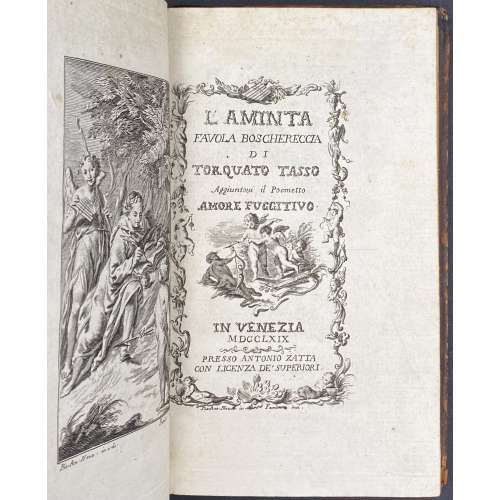 Engraved title-page: L'AMINTA | FAVOLA BOSCHERECCIA | DI | TORQUATO TASSO | Aggiuntovi il Poemetto | Amore Fugitivo |{vignette} | IN VENEZIA | MDCCLXIX |—| PRESSO ANTONIO ZATTA | CON LICENZA DE’ SUPERIORI || in historiated frame, signed below: “Pet. Ant. Novelli in — Fambrini inci.” Pagination: [i] ii-xxiv, [1-2] 3-84, total 108 pages, ils. Collation: 12mo; a12, A-C12 D6, last blank; first 6 leaves signed in 12-leave quires, first 3 in D; total 54 leaves plus 9 plates, incl. engraved title and frontispiece, and numerous head- and tailpieces by Fambrini after Novelli. Binding: 18.6 x 11 cm, contemporary tree calf, rebacked, crimson label with gilt lettering; clipping and bookplate of The Robin Collection to front pastedown; verso front flyleaf stamped “RESTORED BY MACDONALD CO. | NORWALK. CONN.” Additional blank leaves at front and back. Provenance: Satinsky, Robin F. (American, 1919 – 2008); The Robin Collection. Contributors: Torquato Tasso (Italian, 1544 –1595) – author. Pietro Antonio Novelli (Italian, 1729 – 1804) – artist. Ferdinando Fambrini (Italian (1764 – c.1793) – engraver. Antonio Zatta (Italian, c. 1722 – 1804) – printer, publisher.
Engraved title-page: L'AMINTA | FAVOLA BOSCHERECCIA | DI | TORQUATO TASSO | Aggiuntovi il Poemetto | Amore Fugitivo |{vignette} | IN VENEZIA | MDCCLXIX |—| PRESSO ANTONIO ZATTA | CON LICENZA DE’ SUPERIORI || in historiated frame, signed below: “Pet. Ant. Novelli in — Fambrini inci.” Pagination: [i] ii-xxiv, [1-2] 3-84, total 108 pages, ils. Collation: 12mo; a12, A-C12 D6, last blank; first 6 leaves signed in 12-leave quires, first 3 in D; total 54 leaves plus 9 plates, incl. engraved title and frontispiece, and numerous head- and tailpieces by Fambrini after Novelli. Binding: 18.6 x 11 cm, contemporary tree calf, rebacked, crimson label with gilt lettering; clipping and bookplate of The Robin Collection to front pastedown; verso front flyleaf stamped “RESTORED BY MACDONALD CO. | NORWALK. CONN.” Additional blank leaves at front and back. Provenance: Satinsky, Robin F. (American, 1919 – 2008); The Robin Collection. Contributors: Torquato Tasso (Italian, 1544 –1595) – author. Pietro Antonio Novelli (Italian, 1729 – 1804) – artist. Ferdinando Fambrini (Italian (1764 – c.1793) – engraver. Antonio Zatta (Italian, c. 1722 – 1804) – printer, publisher. -
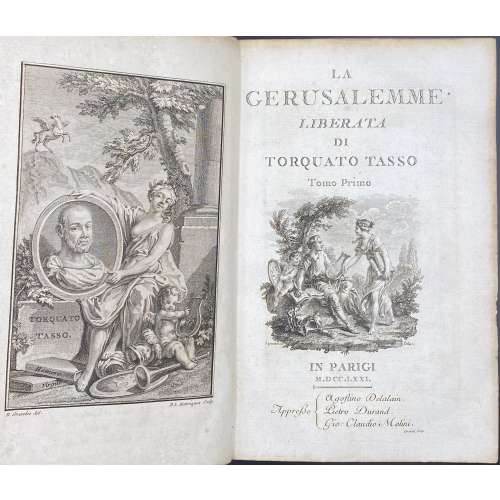 A two-volume set. Vol. 1:
A two-volume set. Vol. 1:Title: LA | GERUSALEMME | LIBERATA | DI | TORQUATO TASSO | Tomo Primo | {vignette} | IN PARIGI | M.DCC.LXXI | Appreßo { Agostino Delalain. | Pietro Durand. | Gio: Claudio Molini. | Droüet ∫crip.
Pagination: ffl [1] 2-331 [332] bfl; illustrations after Gravelot: frontis. by Henriquez, t.p. vignette by Patas, engraved dedication by Le Roy, 10 head- and 7 tailpieces by Le Roy, 5 full-page vignettes by Le Roy, and 10 plates by: Baquoy, Duclos (3), Le Roy, Lingée, Née, Rousseau, and Simonet (2).
Collation: 8vo; A-V8 X6.
Vol. 2: Title: LA | GERUSALEMME | LIBERATA | DI | TORQUATO TASSO | Tomo Secondo | {vignette} | IN PARIGI | M.DCC.LXXI | Appreßo { Agostino Delalain. | Pietro Durand. | Gio: Claudio Molini. | Droüet ∫crip. Pagination: ffl [1] 2-340 bfl; illustrations after Gravelot: frontis. by Henriquez, t.p. vignette by Mesnil, 10 head- and 6 tailpieces by Le Roy, 4 full-page vignettes by Le Roy, tailpiece by Ponce, and 10 plates by: Duclos, Henriquez, Leveau, Lingée, Massard, Née, Patas, Ponce, Rousseau, and Simonet. Collation: 8vo; A-X8 Y2. Size: 21.5 x 14.5 cm. Size of the copy sold at Sotheby's in 2015: 23.3 x 14.0 cm; Christie's in 2008: 23.2 x 14.4 cm Page size: 21 x 13.5 cm. In referenced sources, the page size is bigger than that. N. Ray gives 11 ½ x 8 7⁄8 inches or 9 x 5½ inches. Cohen and De Ricci do not bother to give sizes, considering that octavo is octavo. MFA: 30.3 x 23.1 x 4 cm (11 15/16 x 9 1/8 x 1 9/16 in.) Binding: Two volumes uniformly bound in full marbled calf, ruled in gilt, flat spine with gilt decorations and monogram, cream lettered label. Geoffrey Lord Cross of Chelsea [Geoffrey Cross, Baron Cross of Chelsea] (British, 1904 – 1989) bookplate to front pastedown. Catalogue raisonné: N. Ray №22, p. 48; Cohen De Ricci 974-975 According to MFA printing by: François-Augustin Quillau (French, 1743–1804). This edition was illustrated by Hubert François Gravelot (French, 1699–1773) and engraved by the following engravers: Jean Charles Baquoy (French, 1721–1777) Antoine Jean Duclos (French, 1742–1795) Benoît Louis Henriquez (French, 1732–1806) Jean Jacques André Le Veau (French, 1729–1785) Charles Louis Lingée (French, 1748–1819) Jacques Le Roy (French, born in 1739) Jean Massard (1740–1822) Elie du Mesnil (French, born about 1728) François Denis Née (French, 1735–1818) Charles Emmanuel Jean Baptiste Patas (French, 1744–1802) Nicholas Ponce (French, 1746–1831) Jean François Rousseau (French, born in 1740) Jean Baptiste Simonet (French, 1742–1813) Droüet (French, 18th century) -
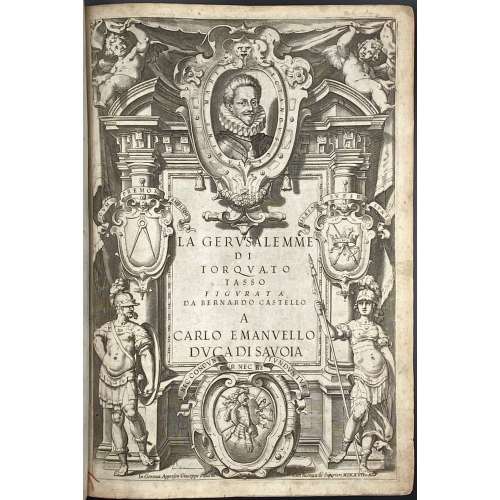 Engraved title-page 1, as per British Museum: An architectural setting with, at upper centre, a portrait of Carlo Emanuele I, Duke of Savoy, in an ornate cartouche lettered “"Spectandus Certamine Martio"; a central title “LA | GERUSALEMME | DI | TORQUATO | TASSO | FUGURATA A | DA BERNARDO CASTELLO | A | CARLO EMANUELLO | DVCA DI SAVOIA” flanked by Tuscan columns and crests with mottos and imprese showing compasses lettered "Dvm Premor Amplior", at left, and a crossed sword and sceptre with a crown lettered "Illaesa Super Sunt", at right; in the lower register, male and female figures in armour, perhaps representing Tancredi and Clorinda, with a central crest showing an impresa of armour”. Central title: Below, within frame: "In Genova, Appresso Giuseppe Pavoni. […] Con licenza de' Superiori. MDCXVII." Engraved title-page 2, as per British Museum: Portrait of Torquato Tasso, bust, facing front, wearing a laurel crown; within an oval pendant, lettered “TOROVATO […] TASSO EF”, suspended from a pediment, beneath which a view of Genoa is flanked by two columns, and above is a tablet, lettered: “LA GERUSALEMME | LIBERATA | DI TORQUATO | TASSO. | Con le annotazioni | di Scipion | Gentili, e di Givlio | Guastauini , | Et li argomenti di Oratio Ariosti , | STAMPATA | Per Giuseppe Pauoni ad instanza di | Bernardo Castello,in Genova | L’Anno MDCXVII." Collation: 8vo; 2 leaves of engraved title-pages, 1 leaf signed †2, 1 leaf unsigned, 2 leaves signed †† and ††2, respectively, 1 leaf unsigned, 1 leaf with engraving to verso (frontispiece to Canto Primo) —> 8 prelims (besides FEP or a blank leaf before 1st t.p.); π8 A-Q8 (pp. 1-255 [256 blank], plated within collation), G1, I1, K1, O1, and P1 (recto to plates without text) unsigned, L3 signed as second L2; A-D8 E4 (pp. 1-71 [72]; A-B8 C4 χ1 (pp. [1] 2-36 [37-40] [2]), in the 4-leaf quires E and C only two first leaves signed, in the 8-leaf quires four first leaves signed. Illustrations: woodcut head- and tail-pieces, woodcut initials, some historiated, and 20 plates within collation and pagination engraved by Camillo Cungio after Bernardo Castello. Binding: 30.5 x 21.4 cm overall, 30 x 20.5 cm leaves; contemporary vellum, rebacked with modern brown morocco, crimson morocco label with gilt lettering and double-fillet outline. Two bookplates to front pastedown: (1) Chippendale armorial bookplate (8.3 x 7.6 cm): Thos. Brand Esqr. Signed: W Austin — Fecit; (2) The Robin Collection bookplate. Bookseller’s ticket to back pastedown: “J. POOLE. | British & foreign | BOOKSELLER, | 39 BOOKSELLERS ROW, | STRAND |〰️| Books Bought.” All edges green. Provenance: The Robin Collection; Thomas Brand Hollis (British, 1719 – 1804). Contributors: Torquato Tasso (Italian, 1544 –1595) – author. Scipione Gentili [Scipio Gentilis] (Italian, 1563 – 1616) – author. Giulio Guastavini (Italian, fl. 16th century) – author. Bernardo Castello [Castelli] (Italian, 1557 – 1629) – artist. Camillo Cungi (Italian, fl. 1597 – 1649) – engraver. Giuseppe Pavoni (Italian, 1551 – c. 1641) – printer, publisher. Carlo Emanuele I, Duke of Savoy (Italian, 1562 – 1630) – dedicatee.
Engraved title-page 1, as per British Museum: An architectural setting with, at upper centre, a portrait of Carlo Emanuele I, Duke of Savoy, in an ornate cartouche lettered “"Spectandus Certamine Martio"; a central title “LA | GERUSALEMME | DI | TORQUATO | TASSO | FUGURATA A | DA BERNARDO CASTELLO | A | CARLO EMANUELLO | DVCA DI SAVOIA” flanked by Tuscan columns and crests with mottos and imprese showing compasses lettered "Dvm Premor Amplior", at left, and a crossed sword and sceptre with a crown lettered "Illaesa Super Sunt", at right; in the lower register, male and female figures in armour, perhaps representing Tancredi and Clorinda, with a central crest showing an impresa of armour”. Central title: Below, within frame: "In Genova, Appresso Giuseppe Pavoni. […] Con licenza de' Superiori. MDCXVII." Engraved title-page 2, as per British Museum: Portrait of Torquato Tasso, bust, facing front, wearing a laurel crown; within an oval pendant, lettered “TOROVATO […] TASSO EF”, suspended from a pediment, beneath which a view of Genoa is flanked by two columns, and above is a tablet, lettered: “LA GERUSALEMME | LIBERATA | DI TORQUATO | TASSO. | Con le annotazioni | di Scipion | Gentili, e di Givlio | Guastauini , | Et li argomenti di Oratio Ariosti , | STAMPATA | Per Giuseppe Pauoni ad instanza di | Bernardo Castello,in Genova | L’Anno MDCXVII." Collation: 8vo; 2 leaves of engraved title-pages, 1 leaf signed †2, 1 leaf unsigned, 2 leaves signed †† and ††2, respectively, 1 leaf unsigned, 1 leaf with engraving to verso (frontispiece to Canto Primo) —> 8 prelims (besides FEP or a blank leaf before 1st t.p.); π8 A-Q8 (pp. 1-255 [256 blank], plated within collation), G1, I1, K1, O1, and P1 (recto to plates without text) unsigned, L3 signed as second L2; A-D8 E4 (pp. 1-71 [72]; A-B8 C4 χ1 (pp. [1] 2-36 [37-40] [2]), in the 4-leaf quires E and C only two first leaves signed, in the 8-leaf quires four first leaves signed. Illustrations: woodcut head- and tail-pieces, woodcut initials, some historiated, and 20 plates within collation and pagination engraved by Camillo Cungio after Bernardo Castello. Binding: 30.5 x 21.4 cm overall, 30 x 20.5 cm leaves; contemporary vellum, rebacked with modern brown morocco, crimson morocco label with gilt lettering and double-fillet outline. Two bookplates to front pastedown: (1) Chippendale armorial bookplate (8.3 x 7.6 cm): Thos. Brand Esqr. Signed: W Austin — Fecit; (2) The Robin Collection bookplate. Bookseller’s ticket to back pastedown: “J. POOLE. | British & foreign | BOOKSELLER, | 39 BOOKSELLERS ROW, | STRAND |〰️| Books Bought.” All edges green. Provenance: The Robin Collection; Thomas Brand Hollis (British, 1719 – 1804). Contributors: Torquato Tasso (Italian, 1544 –1595) – author. Scipione Gentili [Scipio Gentilis] (Italian, 1563 – 1616) – author. Giulio Guastavini (Italian, fl. 16th century) – author. Bernardo Castello [Castelli] (Italian, 1557 – 1629) – artist. Camillo Cungi (Italian, fl. 1597 – 1649) – engraver. Giuseppe Pavoni (Italian, 1551 – c. 1641) – printer, publisher. Carlo Emanuele I, Duke of Savoy (Italian, 1562 – 1630) – dedicatee. -
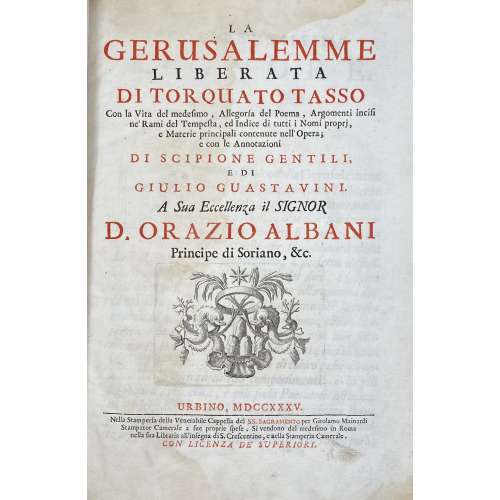 Title page (in red and black): LA | GERUSALEMME | LIBERATA | DI TORQUATO TASSO | Con la Vita del medesimo , Allegoria del Poema , Argomenti incisi | ne’Rami del Tempesta , ed Indice di tutti i Nomi proprj , | e Materie principali contenute nell’Opera ; | e con le Annotazioni | DI SCIPIONE GENTILI | E DI | GIULIO GUASTAVINI. | A Sua Eccellenza il SIGNOR | D. ORAZIO ALBANI | Principe di Soriano, &c. | {printer’s device} | URBINO, MDCCXXXV. | — | Nella Stamperia della Venerabile Cappella del SS. SAGRAMENTO per Girolamo Mainardi | Stampator Camerale a sue proprie spese . Si vendono dal medesimo in Roma | nella sua Libraria all’insegna di S. Crescentino, e nella Stamperia Camerale | CON LICENZA DE SUPERIORI. || Half-title: Title page: IL | GOFFREDO | OVVERO | LA GERUSALEMME | LIBERATA | DI | TORQUATO TASSO. || Collation: 4to; [2] blank leaves, [1] – h.t. / blank, [1] – t.p. / blank, [1] – dedication signed *2, [2] – vita, 1st signed *3, [2] – allegoria, [3] – indice, first two signed ** and **2, respectively, [1] – frontispiece to Canto Primo —> total 13 prelims; π13 (incl. 2 blanks), A-Z4 Aa-Bb4 Cc6 Dd-Qq4, χ1 (blank); 20 engraved frontispieces, one headpiece and initials, some historiated. Frontis. to Cantos II-XX incl. in collation and pagination; the number of leaves from A1 to Qq4 = 158; pagination: 1-316. The total number of leaves incl. prelims and blanks = 172. Note: three first leaves in the Cc quire of six leaves are signed; all other four-leaf quires only have the first two first leaves signed. Frontispiece to Canto Quarto cut down and laid down on D2v (as in Christie’s copy sold on 6 Jun 2010 – Live Auction 5475 – Fine Printed Books and Manuscripts, lot 168, price realized GBP 600). Illustrations: Frontispiece to Canto Primo signed “Arnoldo van Westerhout formis Roma”. Headpiece to Canto Primo signed “Eq. Petrus Leo Ghezius Inu. et. delin. — Frãn. Aquila incid.” Other plates unsigned but all attributed to Westerhout after Antonio Tempesta; Numeration of frontispieces in roman numbers, IIII for VI, VIIII for IX, XIIII for XIV, inverted numbers XVII, XVIII, and XIX, respectively: IIVX, IIIVX, and IIIIVX. Binding: 35 x 24 cm, 34 x 23 cm leaves, contemporary calf, rebacked retaining original spine, verso front flyleaf stamped “RESTORED BY MACDONALD CO. | NORWALK. CONN. Marbled endpapers, all edges red. Speckled calf, gilt triple-fillet borders, with remnants of blind-stamped and gilt design to an upper inside corner, spine with raised bands, gilt acorn tooling in compartments, later crimson label with gilt lettering. Damp staining to inside edges affecting all leaves. The Robin Collection bookplate to front pastedown. Provenance: The Robin Collection. Contributors: Torquato Tasso (Italian, 1544 –1595) – author. Scipione Gentili [Scipio Gentilis] (Italian, 1563 – 1616) Giulio Guastavini (Italian, fl. 16th century) Antonio Tempesta [Tempestino] (Italian, 1555 – 1630) – artist. Arnold [Arnoldo] van Westerhout (Flemish, 1651 – 1725) – artist, engraver. Pier Leone Ghezzi (Italian, 1674 – 1755) – artist. Francesco Faraone Aquila (Italian, c. 1676 – c. 1740) – engraver. Girolamo Mainardi (Italian, c. 1679 circa – 1763) – printer, publisher. Orazio Albani (Italian, 1576 – 1653) – dedicatee.
Title page (in red and black): LA | GERUSALEMME | LIBERATA | DI TORQUATO TASSO | Con la Vita del medesimo , Allegoria del Poema , Argomenti incisi | ne’Rami del Tempesta , ed Indice di tutti i Nomi proprj , | e Materie principali contenute nell’Opera ; | e con le Annotazioni | DI SCIPIONE GENTILI | E DI | GIULIO GUASTAVINI. | A Sua Eccellenza il SIGNOR | D. ORAZIO ALBANI | Principe di Soriano, &c. | {printer’s device} | URBINO, MDCCXXXV. | — | Nella Stamperia della Venerabile Cappella del SS. SAGRAMENTO per Girolamo Mainardi | Stampator Camerale a sue proprie spese . Si vendono dal medesimo in Roma | nella sua Libraria all’insegna di S. Crescentino, e nella Stamperia Camerale | CON LICENZA DE SUPERIORI. || Half-title: Title page: IL | GOFFREDO | OVVERO | LA GERUSALEMME | LIBERATA | DI | TORQUATO TASSO. || Collation: 4to; [2] blank leaves, [1] – h.t. / blank, [1] – t.p. / blank, [1] – dedication signed *2, [2] – vita, 1st signed *3, [2] – allegoria, [3] – indice, first two signed ** and **2, respectively, [1] – frontispiece to Canto Primo —> total 13 prelims; π13 (incl. 2 blanks), A-Z4 Aa-Bb4 Cc6 Dd-Qq4, χ1 (blank); 20 engraved frontispieces, one headpiece and initials, some historiated. Frontis. to Cantos II-XX incl. in collation and pagination; the number of leaves from A1 to Qq4 = 158; pagination: 1-316. The total number of leaves incl. prelims and blanks = 172. Note: three first leaves in the Cc quire of six leaves are signed; all other four-leaf quires only have the first two first leaves signed. Frontispiece to Canto Quarto cut down and laid down on D2v (as in Christie’s copy sold on 6 Jun 2010 – Live Auction 5475 – Fine Printed Books and Manuscripts, lot 168, price realized GBP 600). Illustrations: Frontispiece to Canto Primo signed “Arnoldo van Westerhout formis Roma”. Headpiece to Canto Primo signed “Eq. Petrus Leo Ghezius Inu. et. delin. — Frãn. Aquila incid.” Other plates unsigned but all attributed to Westerhout after Antonio Tempesta; Numeration of frontispieces in roman numbers, IIII for VI, VIIII for IX, XIIII for XIV, inverted numbers XVII, XVIII, and XIX, respectively: IIVX, IIIVX, and IIIIVX. Binding: 35 x 24 cm, 34 x 23 cm leaves, contemporary calf, rebacked retaining original spine, verso front flyleaf stamped “RESTORED BY MACDONALD CO. | NORWALK. CONN. Marbled endpapers, all edges red. Speckled calf, gilt triple-fillet borders, with remnants of blind-stamped and gilt design to an upper inside corner, spine with raised bands, gilt acorn tooling in compartments, later crimson label with gilt lettering. Damp staining to inside edges affecting all leaves. The Robin Collection bookplate to front pastedown. Provenance: The Robin Collection. Contributors: Torquato Tasso (Italian, 1544 –1595) – author. Scipione Gentili [Scipio Gentilis] (Italian, 1563 – 1616) Giulio Guastavini (Italian, fl. 16th century) Antonio Tempesta [Tempestino] (Italian, 1555 – 1630) – artist. Arnold [Arnoldo] van Westerhout (Flemish, 1651 – 1725) – artist, engraver. Pier Leone Ghezzi (Italian, 1674 – 1755) – artist. Francesco Faraone Aquila (Italian, c. 1676 – c. 1740) – engraver. Girolamo Mainardi (Italian, c. 1679 circa – 1763) – printer, publisher. Orazio Albani (Italian, 1576 – 1653) – dedicatee. -
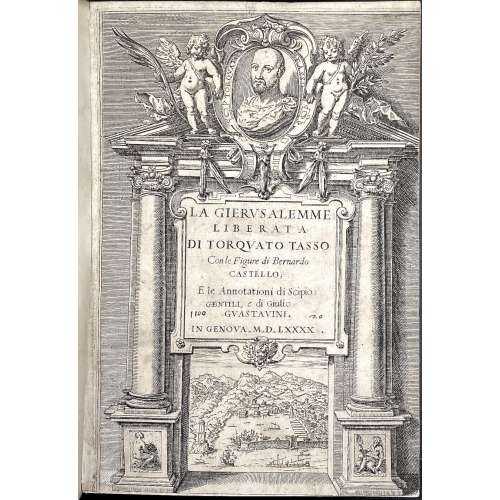 Engraved title with the portrait of Torquato Tasso, displayed in an oval medallion, bound in “TORQUATO TASSO”, between two naked putti; Architecture with two columns and Ionic capitals supporting an architectural pediment; between the columns is a table with the inscription: LA GIERVSALEMME | LIBERATA | DI TORQVATO TASSO | Con le Figure di Bernardo | CASTELLO; | E le Annotazioni di Scipio | GENTILI, e di Giulio | GVASTAVINI. | IN GENOVA. M.D.LXXXX .|| Contents: The 20 cantos are followed by: Tutte le stanza intere, che dall'autore sono state refiutate in questo libro; Annotationi di Scipio Gentili; Luoghi osservati dal mag. Giulio Guastavini, quali il Tasso nella sua Gierusalemme hà presi & imitati da poeti & altri scrittori antichi; Allegoria del poema; Tavola di tutti i nomi proprii et di tutte le materie principali contenute nel presente libro. Pagination: [2] engraved t.p. / blank, 3-11, [1] 2-255 [256], 1-71 [72] [1] 2-40, 4 unpag. leaves ‘Allegoria del poema’; total 387 pp. Collation: 8vo; π6 A-Q8 A-D8 E4 A-B8 χ4 (in the first quire M4 marked L4), ills. signed in collation. At p. 17 canto 3rd marked as 2nd, pp. 135 and 139 in 12th canto marked as 11th. Binding: later full polished calf, blind double-ruled covers, blind double-ruled raised bands, gilt lettering: GIERVSALEMME | LIBERATA and GENOVA | 1590. TMG. Printed on laid paper. Front joints split at head and tail. Title page and twenty full-page ill. facing the opening of each canto, engraved by Agostino Carracci and Giacomo Franco after Castello. Those for cantos 6-8, 10, 12, 16-17, 19-20 are by Carracci, 8 and 19 with his initials. The remainder are by Franco and are signed by him. Woodcut head and tailpieces, the Argomenti at the head of each canto within cartouches, initials. Catalogue raisonné: Adam Bartsch. Le peintre graveur. — Vienne: J. V. Degen, 1803.
Engraved title with the portrait of Torquato Tasso, displayed in an oval medallion, bound in “TORQUATO TASSO”, between two naked putti; Architecture with two columns and Ionic capitals supporting an architectural pediment; between the columns is a table with the inscription: LA GIERVSALEMME | LIBERATA | DI TORQVATO TASSO | Con le Figure di Bernardo | CASTELLO; | E le Annotazioni di Scipio | GENTILI, e di Giulio | GVASTAVINI. | IN GENOVA. M.D.LXXXX .|| Contents: The 20 cantos are followed by: Tutte le stanza intere, che dall'autore sono state refiutate in questo libro; Annotationi di Scipio Gentili; Luoghi osservati dal mag. Giulio Guastavini, quali il Tasso nella sua Gierusalemme hà presi & imitati da poeti & altri scrittori antichi; Allegoria del poema; Tavola di tutti i nomi proprii et di tutte le materie principali contenute nel presente libro. Pagination: [2] engraved t.p. / blank, 3-11, [1] 2-255 [256], 1-71 [72] [1] 2-40, 4 unpag. leaves ‘Allegoria del poema’; total 387 pp. Collation: 8vo; π6 A-Q8 A-D8 E4 A-B8 χ4 (in the first quire M4 marked L4), ills. signed in collation. At p. 17 canto 3rd marked as 2nd, pp. 135 and 139 in 12th canto marked as 11th. Binding: later full polished calf, blind double-ruled covers, blind double-ruled raised bands, gilt lettering: GIERVSALEMME | LIBERATA and GENOVA | 1590. TMG. Printed on laid paper. Front joints split at head and tail. Title page and twenty full-page ill. facing the opening of each canto, engraved by Agostino Carracci and Giacomo Franco after Castello. Those for cantos 6-8, 10, 12, 16-17, 19-20 are by Carracci, 8 and 19 with his initials. The remainder are by Franco and are signed by him. Woodcut head and tailpieces, the Argomenti at the head of each canto within cartouches, initials. Catalogue raisonné: Adam Bartsch. Le peintre graveur. — Vienne: J. V. Degen, 1803.Author: Written by Torquato Tasso (Italian, Sorrento 1544–1595 Rome)
Designer: Illustrations designed by Bernardo Castello (Italian, Genoa (?) 1557–1629 Genoa)
Engraver: Illustrations engraved by Agostino Carracci (Italian, Bologna 1557–1602 Parma)
Engraver: Illustrations engraved by Giacomo Franco (Italian, Venice 1550–1620 Venice)
Publisher: Published by Girolamo Bartoli , Genoa
Ref.: MET, HathiTrust, -
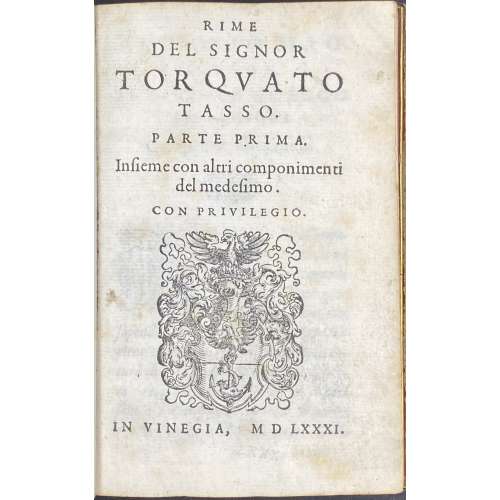 Title-page: RIME | DEL SIGNOR | TORQUATO | TASSO. | PARTE PRIMA. | Insieme con altri componimenti | del medesimo | CON PRIVILEGIO. | {publisher’s device} | IN VINEGIA, M D LXXXI. || Contents: 1. Rime; 2. Aminta favola boscareccia; 3. Conclusioni amorose; 4. Il Romeo, overo del Giuoco dialogo; 5. Lettera, nellaquale paragona l’Italia alla Francia; 6. All’eccellentis signor Duca di Urbino; 7. Dialogo del l’amor. Pagination: [2 blanks], [2] – t.p. / blank, [4] dedication, [2] – blank / content, [16] – tavola, [1] 2-160 – rime, [8] [1] 2-74 – aminta, [4] 1-9 [10 blank] – conclusion, [2] [1]-22 – dialogo, [2] 1-27 [28 blank] – lettera, [2] 1-4 – all’eccellentiss, [4 blanks], [2] 1-17 [18 blank] – dialogo del l’amor, [2] – Car. 52 / Car. 113., [4 blanks], total 372 pages. Collation: 8vo; first blank, *4, **8, A-K8, 2A-2L8 M4, last blank; total 186 leaves, incl. first and last blanks. Note: 2F2, 2G1, 2K4, 2L1, and 2M3,4 – unsigned. Binding: 15.2 x 10.3 cm, 19th-century polished calf by Duke St., St. James, London (ticket) Cambridge panels ruled in gilt with fleurons at corners, two crimson labels to spine with gilt lettering, gilt in compartments, raised bands ruled gilt, rebacked, AEG, bookplate to front pastedown: “BIBLIOTECA | del | Conte Leonardo Vitetti | Ambasciatore d’Italia” in a frame, and “The Robin Collection” to FEP. Inset a card from Bryn Mawr College Library. Provenance: Satinsky, Robin F. (American, 1919 – 2008), The Robin Collection. Count Leonardo Vitetti (Italian, 1895 – 1973) Bryn Mawr College Library (Pennsylvania) Contributors: Torquato Tasso (Italian, 1544 –1595) – author. Aldus Manutius, the Younger (Italian, 1547 – 1597) – printer, publisher.
Title-page: RIME | DEL SIGNOR | TORQUATO | TASSO. | PARTE PRIMA. | Insieme con altri componimenti | del medesimo | CON PRIVILEGIO. | {publisher’s device} | IN VINEGIA, M D LXXXI. || Contents: 1. Rime; 2. Aminta favola boscareccia; 3. Conclusioni amorose; 4. Il Romeo, overo del Giuoco dialogo; 5. Lettera, nellaquale paragona l’Italia alla Francia; 6. All’eccellentis signor Duca di Urbino; 7. Dialogo del l’amor. Pagination: [2 blanks], [2] – t.p. / blank, [4] dedication, [2] – blank / content, [16] – tavola, [1] 2-160 – rime, [8] [1] 2-74 – aminta, [4] 1-9 [10 blank] – conclusion, [2] [1]-22 – dialogo, [2] 1-27 [28 blank] – lettera, [2] 1-4 – all’eccellentiss, [4 blanks], [2] 1-17 [18 blank] – dialogo del l’amor, [2] – Car. 52 / Car. 113., [4 blanks], total 372 pages. Collation: 8vo; first blank, *4, **8, A-K8, 2A-2L8 M4, last blank; total 186 leaves, incl. first and last blanks. Note: 2F2, 2G1, 2K4, 2L1, and 2M3,4 – unsigned. Binding: 15.2 x 10.3 cm, 19th-century polished calf by Duke St., St. James, London (ticket) Cambridge panels ruled in gilt with fleurons at corners, two crimson labels to spine with gilt lettering, gilt in compartments, raised bands ruled gilt, rebacked, AEG, bookplate to front pastedown: “BIBLIOTECA | del | Conte Leonardo Vitetti | Ambasciatore d’Italia” in a frame, and “The Robin Collection” to FEP. Inset a card from Bryn Mawr College Library. Provenance: Satinsky, Robin F. (American, 1919 – 2008), The Robin Collection. Count Leonardo Vitetti (Italian, 1895 – 1973) Bryn Mawr College Library (Pennsylvania) Contributors: Torquato Tasso (Italian, 1544 –1595) – author. Aldus Manutius, the Younger (Italian, 1547 – 1597) – printer, publisher.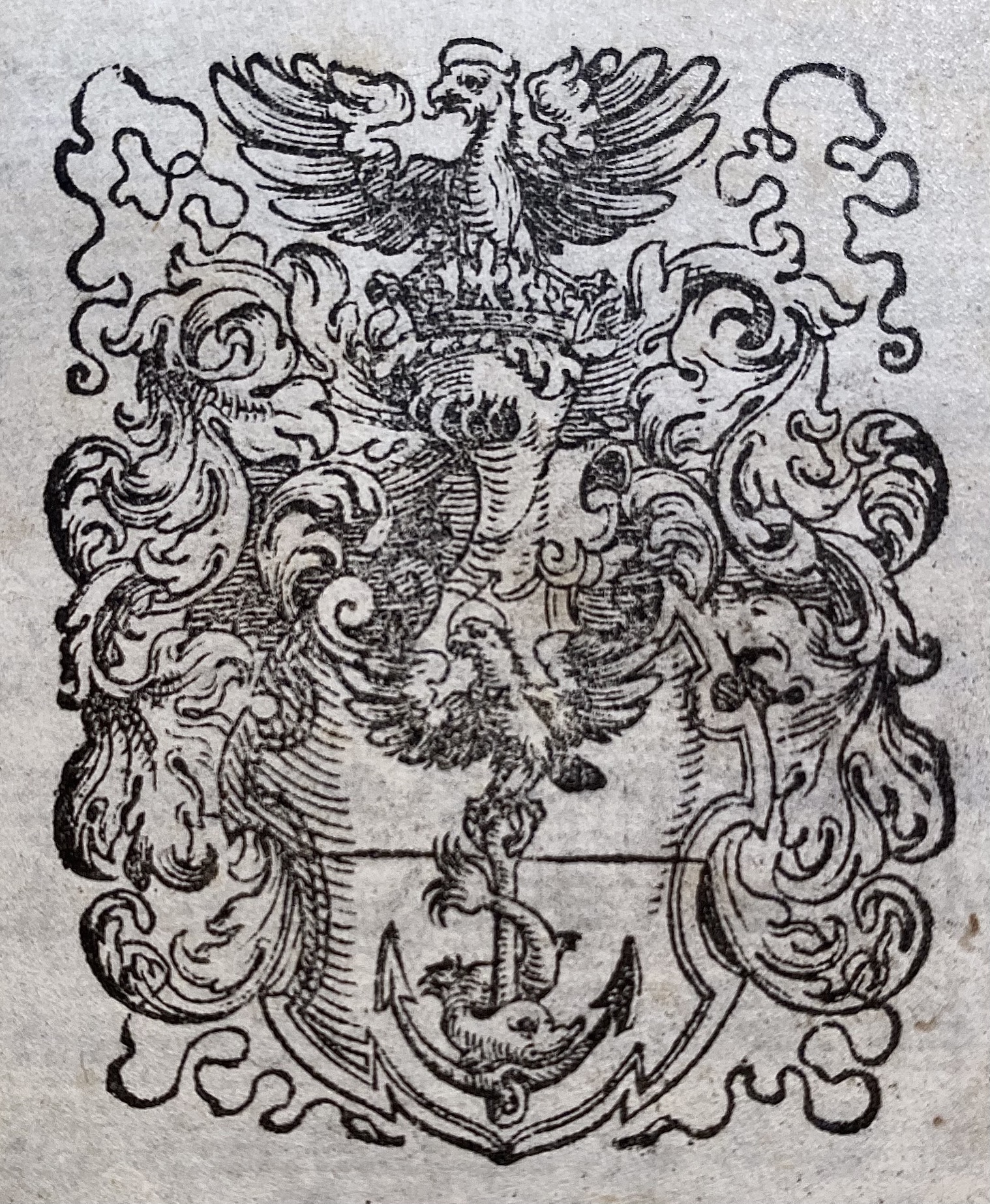
-
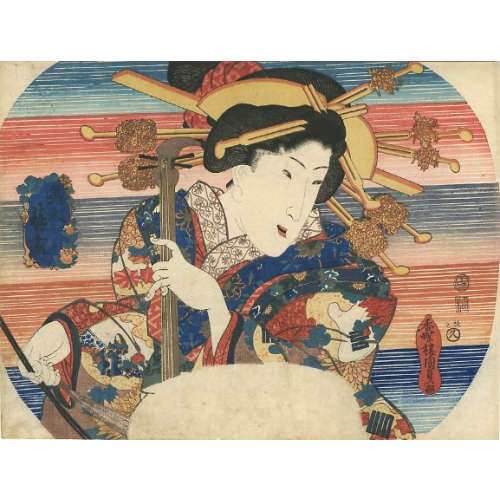 A young woman playing a four-string musical instrument with a bow (kokyū). Series: Assortments of Beauties Accomplishments [美人芸盡] (Bijin gei-zukushi). Utagawa Kunisada [歌川 国貞]; a.k.a. Utagawa Toyokuni III [三代歌川豊国] (Japanese, 1786 – 1865). Signed: Kochoro Kunisada ga [香蝶楼 国貞画] in a red double gourd cartouche. Publisher: Ibaya Kyūbei [伊場屋久兵衛] (Japanese, 1804 – 1851); seal: Hanmoto, Kyū [板元久] (Marks 19-040 | 126e) Date seal: Bunsei 12 (1829). Censors' seal: Kiwame. Size: Fan print (uchiwa-e).
A young woman playing a four-string musical instrument with a bow (kokyū). Series: Assortments of Beauties Accomplishments [美人芸盡] (Bijin gei-zukushi). Utagawa Kunisada [歌川 国貞]; a.k.a. Utagawa Toyokuni III [三代歌川豊国] (Japanese, 1786 – 1865). Signed: Kochoro Kunisada ga [香蝶楼 国貞画] in a red double gourd cartouche. Publisher: Ibaya Kyūbei [伊場屋久兵衛] (Japanese, 1804 – 1851); seal: Hanmoto, Kyū [板元久] (Marks 19-040 | 126e) Date seal: Bunsei 12 (1829). Censors' seal: Kiwame. Size: Fan print (uchiwa-e). -
 An uncut fan print shows a young woman holding a basket on a landscape background with hills and pines under a rising sun. Haruo Shirane: "Under the luni-solar calendar, the New Year coincided with the beginning of spring, making it the most important observance of the year for the aristocracy. In the Heian period, New Year ceremonies extended from New Year’s Day (Ganjitsu) to the Day of the Rat (Nenohi), which usually fell on the seventh day of the First Month, when courtiers went out to the fields (no), pulled up small pines, and gathered new herbs (wakana) as a prayer for long life. This ritual gradually spread to the provinces and to commoners, eventually resulting in the New Year practice of the gate pine (kadomatsu), in which a pair of small pines was placed at the gate of a house. A popular Heian-period painting topic representing the First Month was “prayers on the Day of the Rat” (Nenohi no asobi), which depicted the auspicious scene of pulling up small pines in a spring field. Both young herbs and gathering young herbs, particularly at Kasuga Field, became major poetic topics for the First Month, appearing in both the spring and celebration (ga) books of the Kokinshū (Collection of Japanese Poems Old and New, ca. 905). By the Kamakura period, the observance of the Day of the Rat had been abandoned at the imperial court, but the custom of gathering and eating young greens continued as the annual ceremony known as the Seven Grasses (Nanakusa). Note: The Heian-period ritual of pulling up the roots of small pines (komatsu ) on the first Day of the Rat derives from the homonyms ne (rat) and ne (root). Pulling up roots was auspicious, since it implied lengthening the year. The rising sun (hinode) was considered an auspicious sight, particularly at the beginning of the year". [Haruo Shirane, Japan and the Culture of the Four Seasons. Nature, Literature, and the Arts. — Columbia University, NY, 2012]. Title: Gathering of the young herbs on the Day of the Rat [子の日乃若菜] (Nenohi no wakana). Series: Three elegant sources of light [風流三光の内] (fūryū sankō no uchi); meaning the sun, the moon and the stars). Artist: Utagawa Kunisada [歌川 国貞]; a.k.a. Utagawa Toyokuni III [三代歌川豊国] (Japanese, 1786 – 1865). Signed: Toyokuni ga [豊国 画] in a yellow toshidama cartouche. Publisher’s seal: Izuzen (Marks: seal 06-029 | U103b) Date and double nanushi censor seals: Mera and Watanabe, Kaei 6 (1853). A similar theme can be found in Kunisadai's triptych published in about 1844 (HARA SHOBO):
An uncut fan print shows a young woman holding a basket on a landscape background with hills and pines under a rising sun. Haruo Shirane: "Under the luni-solar calendar, the New Year coincided with the beginning of spring, making it the most important observance of the year for the aristocracy. In the Heian period, New Year ceremonies extended from New Year’s Day (Ganjitsu) to the Day of the Rat (Nenohi), which usually fell on the seventh day of the First Month, when courtiers went out to the fields (no), pulled up small pines, and gathered new herbs (wakana) as a prayer for long life. This ritual gradually spread to the provinces and to commoners, eventually resulting in the New Year practice of the gate pine (kadomatsu), in which a pair of small pines was placed at the gate of a house. A popular Heian-period painting topic representing the First Month was “prayers on the Day of the Rat” (Nenohi no asobi), which depicted the auspicious scene of pulling up small pines in a spring field. Both young herbs and gathering young herbs, particularly at Kasuga Field, became major poetic topics for the First Month, appearing in both the spring and celebration (ga) books of the Kokinshū (Collection of Japanese Poems Old and New, ca. 905). By the Kamakura period, the observance of the Day of the Rat had been abandoned at the imperial court, but the custom of gathering and eating young greens continued as the annual ceremony known as the Seven Grasses (Nanakusa). Note: The Heian-period ritual of pulling up the roots of small pines (komatsu ) on the first Day of the Rat derives from the homonyms ne (rat) and ne (root). Pulling up roots was auspicious, since it implied lengthening the year. The rising sun (hinode) was considered an auspicious sight, particularly at the beginning of the year". [Haruo Shirane, Japan and the Culture of the Four Seasons. Nature, Literature, and the Arts. — Columbia University, NY, 2012]. Title: Gathering of the young herbs on the Day of the Rat [子の日乃若菜] (Nenohi no wakana). Series: Three elegant sources of light [風流三光の内] (fūryū sankō no uchi); meaning the sun, the moon and the stars). Artist: Utagawa Kunisada [歌川 国貞]; a.k.a. Utagawa Toyokuni III [三代歌川豊国] (Japanese, 1786 – 1865). Signed: Toyokuni ga [豊国 画] in a yellow toshidama cartouche. Publisher’s seal: Izuzen (Marks: seal 06-029 | U103b) Date and double nanushi censor seals: Mera and Watanabe, Kaei 6 (1853). A similar theme can be found in Kunisadai's triptych published in about 1844 (HARA SHOBO):
豊国三代「豊歳子日若菜摘ノ図」
-
 Artist: Utagawa Kunisada [歌川 国貞] a.k.a. Utagawa Toyokuni III [三代歌川豊国] (Japanese, 1786 – 1865). Signed: Gototei Kunisada ga [五渡亭国貞画]. Publisher: Ibaya Kyūbei [伊場屋 久兵衛] (Japanese, 1804 – 1851); seal Marks 08-055|126a. Date-aratame seal: Bunsei 13 / Tenpō 1 (1830). Actor: Nakamura Utaemon IV [中村歌右衛門] (Japanese, 1796 – 1852); other names: Nakamura Shikan II [中村芝翫], Nakamura Tsurusuke I, Nakamura Tōtarō. Play: Yoshitsune’s Letter at Koshigoe [義経腰越状] (Yoshitsune Koshigoe-jo). Uncut fan print (uchiwa-e, 団 扇 絵) depicting kabuki actor Nakamura Shikan [中村芝翫] as Gotobei [五斗兵衛], dressed in a green kimono with hanging wisteria crest (sagari fuji mon) on the shoulder, posing behind a large saké cask. Nakamura Utaemon IV held the name of Nakamura Shikan II from the 11th lunar month of 1825 to the 1st lunar month of 1836. He was born as Hirano Kichitarō in Edo in 1796. Another fan print with the same subject in this collection [SVJP-0349.2021]; there are also more details about the play and its heroes.
Artist: Utagawa Kunisada [歌川 国貞] a.k.a. Utagawa Toyokuni III [三代歌川豊国] (Japanese, 1786 – 1865). Signed: Gototei Kunisada ga [五渡亭国貞画]. Publisher: Ibaya Kyūbei [伊場屋 久兵衛] (Japanese, 1804 – 1851); seal Marks 08-055|126a. Date-aratame seal: Bunsei 13 / Tenpō 1 (1830). Actor: Nakamura Utaemon IV [中村歌右衛門] (Japanese, 1796 – 1852); other names: Nakamura Shikan II [中村芝翫], Nakamura Tsurusuke I, Nakamura Tōtarō. Play: Yoshitsune’s Letter at Koshigoe [義経腰越状] (Yoshitsune Koshigoe-jo). Uncut fan print (uchiwa-e, 団 扇 絵) depicting kabuki actor Nakamura Shikan [中村芝翫] as Gotobei [五斗兵衛], dressed in a green kimono with hanging wisteria crest (sagari fuji mon) on the shoulder, posing behind a large saké cask. Nakamura Utaemon IV held the name of Nakamura Shikan II from the 11th lunar month of 1825 to the 1st lunar month of 1836. He was born as Hirano Kichitarō in Edo in 1796. Another fan print with the same subject in this collection [SVJP-0349.2021]; there are also more details about the play and its heroes. Horst Graebner also noted that the performance took place at Nakamura Theatre in Edo on Bunsei 13/03 (03/1830) (see Waseda University Cultural Resources Database # 100-4224):
Horst Graebner also noted that the performance took place at Nakamura Theatre in Edo on Bunsei 13/03 (03/1830) (see Waseda University Cultural Resources Database # 100-4224):

Toyokuni II
-
 Artist: Utagawa Kunisada [歌川 国貞] a.k.a. Utagawa Toyokuni III [三代歌川豊国] (Japanese, 1786 – 1865). Signed: Kunisada ga [国貞画] in a yellow double-gourd cartouche. Publisher: Ibaya Senzaburo [伊場屋仙三郎] (Japanese, fl. c. 1845 – 1847). Date aratame seal: Bunsei 13 – Tenpō 1 (1830). Actor: Nakamura Utaemon IV [中村歌右衛門] (Japanese, 1796 – 1852); other names: Nakamura Shikan II [二代目中村芝翫], Nakamura Tsurusuke I, Nakamura Tōtarō. Play: Yoshitsune’s Letter at Koshigoe [義経腰越状] (Yoshitsune Koshigoe-jo). Uncut fan print (uchiwa-e, 団 扇 絵), 229 x 267 mm, depicting kabuki actor Nakamura Shikan [中村芝翫] as Gotobei [五斗兵衛]. Nakamura Utaemon IV held the name of Nakamura Shikan II from the 11th lunar month of 1825 to the 1st lunar month of 1836. He was born as Hirano Kichitarō in Edo in 1796. Another fan print with the same subject in this collection [SVJP-0344.2021]:
Artist: Utagawa Kunisada [歌川 国貞] a.k.a. Utagawa Toyokuni III [三代歌川豊国] (Japanese, 1786 – 1865). Signed: Kunisada ga [国貞画] in a yellow double-gourd cartouche. Publisher: Ibaya Senzaburo [伊場屋仙三郎] (Japanese, fl. c. 1845 – 1847). Date aratame seal: Bunsei 13 – Tenpō 1 (1830). Actor: Nakamura Utaemon IV [中村歌右衛門] (Japanese, 1796 – 1852); other names: Nakamura Shikan II [二代目中村芝翫], Nakamura Tsurusuke I, Nakamura Tōtarō. Play: Yoshitsune’s Letter at Koshigoe [義経腰越状] (Yoshitsune Koshigoe-jo). Uncut fan print (uchiwa-e, 団 扇 絵), 229 x 267 mm, depicting kabuki actor Nakamura Shikan [中村芝翫] as Gotobei [五斗兵衛]. Nakamura Utaemon IV held the name of Nakamura Shikan II from the 11th lunar month of 1825 to the 1st lunar month of 1836. He was born as Hirano Kichitarō in Edo in 1796. Another fan print with the same subject in this collection [SVJP-0344.2021]: "...The play Yoshitsune Koshigoe-jo was originally written for the puppet theatre (Bunraku) and staged for the first time in the 7th lunar month of 1754 in Ôsaka at the Toyotakeza. It was a revision of two early plays, Namiki Sōsuke's Nanbantetsu Gotō no Menuki (1735) and Yoshitsune Shin Fukumijō (1744). The title, which suggested that the play focused on Minamoto no Yoshitsune, was in fact dealing with the siege of the Ōsaka Castle, led by Tokugawa Ieyasu to destroy the Toyotomi clan in 1614 and 1615. This play was quickly forbidden because of the 4th act in which Gotobei's wife fired a gun at Yoritomo (this was of course interpreted as an attack on the Shogunate). Yoshitsune Koshigoe-jo was revised in 1770 by Toyotake Ōritsu, who completely rewrote the 4th act for a puppet production at the Kitahorieza in Ōsaka". Yoshitsune Koshigoe-jo was staged for the first time in Edo, at the Ichimuraza on the 9th lunar month of 1790, and is still performed.
Gotobei [五斗兵衛] (Gotohei or Gotobē), one of Yoshitsune’s loyal retainers, is forced to choose between his son’s life or his loyalty to Yoshitsune. Nishikidō brothers, who do not want Gotobei to become Yoshitsune's chief strategist, forced him to drink sake and get asleep. To prove Gotobei's military abilities, Izumi no Saburō fires a gun next to Gotobei's ear, and "he jumps up immediately, in full possession of his senses, ready to repulse any enemy". See: [LIB-1193.2013] Samuel L. Leiter. Kabuki Encyclopedia: An English-language adaptation of Kabuki Jiten. — Westport, CT; London: Greenwood Press, 1979; pp. 266-7).
Ref: [LIB-2993.2022] Fig. 24 in Israel Goldman. Japanese prints and paintings / 40th anniversary; Catalogue 27, 2021.
Two more Kunisada's fan prints (in Paul Griffith's collection), depicting the same actor Nakamura Shikan II as Toneri Matsuōmaru [舎人松王丸] were published in 1832 by Iseya Ichiemon. The play was Sugawara's Secrets of Calligraphy [菅原伝授手習鑑] (Sugawara Denju Tenarai Kagami). See: [LIB-1212.2017] Robert Schaap. Kunisada: Imaging, drama and beauty / Introduction by Sebastian Izzard, contributions by Paul Griffith and Henk. J. Herwig. — Leiden: Hotei Publishing, ©2016.
"...The play Yoshitsune Koshigoe-jo was originally written for the puppet theatre (Bunraku) and staged for the first time in the 7th lunar month of 1754 in Ôsaka at the Toyotakeza. It was a revision of two early plays, Namiki Sōsuke's Nanbantetsu Gotō no Menuki (1735) and Yoshitsune Shin Fukumijō (1744). The title, which suggested that the play focused on Minamoto no Yoshitsune, was in fact dealing with the siege of the Ōsaka Castle, led by Tokugawa Ieyasu to destroy the Toyotomi clan in 1614 and 1615. This play was quickly forbidden because of the 4th act in which Gotobei's wife fired a gun at Yoritomo (this was of course interpreted as an attack on the Shogunate). Yoshitsune Koshigoe-jo was revised in 1770 by Toyotake Ōritsu, who completely rewrote the 4th act for a puppet production at the Kitahorieza in Ōsaka". Yoshitsune Koshigoe-jo was staged for the first time in Edo, at the Ichimuraza on the 9th lunar month of 1790, and is still performed.
Gotobei [五斗兵衛] (Gotohei or Gotobē), one of Yoshitsune’s loyal retainers, is forced to choose between his son’s life or his loyalty to Yoshitsune. Nishikidō brothers, who do not want Gotobei to become Yoshitsune's chief strategist, forced him to drink sake and get asleep. To prove Gotobei's military abilities, Izumi no Saburō fires a gun next to Gotobei's ear, and "he jumps up immediately, in full possession of his senses, ready to repulse any enemy". See: [LIB-1193.2013] Samuel L. Leiter. Kabuki Encyclopedia: An English-language adaptation of Kabuki Jiten. — Westport, CT; London: Greenwood Press, 1979; pp. 266-7).
Ref: [LIB-2993.2022] Fig. 24 in Israel Goldman. Japanese prints and paintings / 40th anniversary; Catalogue 27, 2021.
Two more Kunisada's fan prints (in Paul Griffith's collection), depicting the same actor Nakamura Shikan II as Toneri Matsuōmaru [舎人松王丸] were published in 1832 by Iseya Ichiemon. The play was Sugawara's Secrets of Calligraphy [菅原伝授手習鑑] (Sugawara Denju Tenarai Kagami). See: [LIB-1212.2017] Robert Schaap. Kunisada: Imaging, drama and beauty / Introduction by Sebastian Izzard, contributions by Paul Griffith and Henk. J. Herwig. — Leiden: Hotei Publishing, ©2016.


-
 Uncut fan print (uchiwa-e) with the design of kabuki actor Nakamura Utaemon IV who held the name of Nakamura Shikan II from the 11th lunar month of 1825 to the 12th lunar month of 1835, dressed in a checkered kimono, holding a pipe and surrounded by flying fireflies. Character: Nakamura Utaemon IV [中村歌右衛門] (Japanese, 1796 – 1852); other names: Nakamura Shikan II, Nakamura Tsurusuke I, Nakamura Tōtarō. Series title: Catching fireflies in the floating world [浮世蛍狩] (Ukiyo hotarugari). Artist: Utagawa Kunisada [歌川 国貞], a.k.a. Toyokuni III (Japanese, 1786 – 1865). Signed: Kōchōrō Kunisada ga [香蝶楼国貞画] in a red cartouche. Publisher: Ibaya Kyubei [伊場屋 久兵衛] (Japanese, fl. 1804 – 1851); seal: modified Marks 19-009 | 126d. Censor's seal: Kiwame Date seal: Tenpō 2 (1831). Ref: Kunisada.de, N58. A look-alike yearlier Kunisada's design can be found at kunisada.de, ref. # N120-Z0172-410:
Uncut fan print (uchiwa-e) with the design of kabuki actor Nakamura Utaemon IV who held the name of Nakamura Shikan II from the 11th lunar month of 1825 to the 12th lunar month of 1835, dressed in a checkered kimono, holding a pipe and surrounded by flying fireflies. Character: Nakamura Utaemon IV [中村歌右衛門] (Japanese, 1796 – 1852); other names: Nakamura Shikan II, Nakamura Tsurusuke I, Nakamura Tōtarō. Series title: Catching fireflies in the floating world [浮世蛍狩] (Ukiyo hotarugari). Artist: Utagawa Kunisada [歌川 国貞], a.k.a. Toyokuni III (Japanese, 1786 – 1865). Signed: Kōchōrō Kunisada ga [香蝶楼国貞画] in a red cartouche. Publisher: Ibaya Kyubei [伊場屋 久兵衛] (Japanese, fl. 1804 – 1851); seal: modified Marks 19-009 | 126d. Censor's seal: Kiwame Date seal: Tenpō 2 (1831). Ref: Kunisada.de, N58. A look-alike yearlier Kunisada's design can be found at kunisada.de, ref. # N120-Z0172-410:
Actor Onoe Baikō, artist Kunisada, publisher Ibaya Kyūbei, c. 1820.
-
 Artist: Utagawa Kunisada [歌川 国貞] a.k.a. Utagawa Toyokuni III [三代歌川豊国] (Japanese, 1786 – 1865). Signed: Ichiyōsai Toyokuni hitsu [一陽斎豊国筆]. Inscriptions: [松竹梅] Shochikubai = pine (matsu, 松), bamboo (take, 竹), and plum (ume, 梅) – an auspicious grouping known as “The Three Friends of Winter“; [三福追] (Sanpuku tsui) – the three delights, or pleasures. Date seal and aratame censor seal: Ansei 2, 1st month (1855). Publisher: Ibaya Senzaburō [伊場屋仙三郎] (Japanese, c. 1815 – 1869). Block carver: Yokokawa Takejirō [横川竹二郎] (Japanese, fl. 1845 – 1863); seal: Hori Take [彫竹]. Kabuki actor Onoe Kikugorō V [五代目尾上菊五郎] (Onoe Baikō V, Ichimura Kakitsu IV, Ichimura Uzaemon XIII, Ichimura Kurōemon, Japanese, 1844 – 1903) giving candies to the memorial portrait of his predecessor, Ichimura Takenojō V [市村竹之丞] (Ichimura Uzaemon XII, Ichimura Kamenosuke, Ichimura Toyomatsu, Japanese, 1812 – 1851); the latter is dressed in a green robe adorned with a crest (mon) of a kōrin-style crane in a tortoiseshell (octagon), the hanging scroll border decorated with bamboo under snow; the collar of Onoe's kimono decorated with plum blossoms, another plum blossom arrangement decorates the screen behind him. Actors identified by Horst Graebner. Two fan prints from this series in Varshavsky Collection:
Artist: Utagawa Kunisada [歌川 国貞] a.k.a. Utagawa Toyokuni III [三代歌川豊国] (Japanese, 1786 – 1865). Signed: Ichiyōsai Toyokuni hitsu [一陽斎豊国筆]. Inscriptions: [松竹梅] Shochikubai = pine (matsu, 松), bamboo (take, 竹), and plum (ume, 梅) – an auspicious grouping known as “The Three Friends of Winter“; [三福追] (Sanpuku tsui) – the three delights, or pleasures. Date seal and aratame censor seal: Ansei 2, 1st month (1855). Publisher: Ibaya Senzaburō [伊場屋仙三郎] (Japanese, c. 1815 – 1869). Block carver: Yokokawa Takejirō [横川竹二郎] (Japanese, fl. 1845 – 1863); seal: Hori Take [彫竹]. Kabuki actor Onoe Kikugorō V [五代目尾上菊五郎] (Onoe Baikō V, Ichimura Kakitsu IV, Ichimura Uzaemon XIII, Ichimura Kurōemon, Japanese, 1844 – 1903) giving candies to the memorial portrait of his predecessor, Ichimura Takenojō V [市村竹之丞] (Ichimura Uzaemon XII, Ichimura Kamenosuke, Ichimura Toyomatsu, Japanese, 1812 – 1851); the latter is dressed in a green robe adorned with a crest (mon) of a kōrin-style crane in a tortoiseshell (octagon), the hanging scroll border decorated with bamboo under snow; the collar of Onoe's kimono decorated with plum blossoms, another plum blossom arrangement decorates the screen behind him. Actors identified by Horst Graebner. Two fan prints from this series in Varshavsky Collection:
SVJP-0335.2021
-
 Artist: Utagawa Kunisada [歌川 国貞] a.k.a. Utagawa Toyokuni III [三代歌川豊国] (Japanese, 1786 – 1865). Signed: Ichiyōsai Toyokuni hitsu [一陽斎豊国筆]. Inscriptions: [松竹梅] Shochikubai = pine (matsu, 松), bamboo (take, 竹), and plum (ume, 梅) – an auspicious grouping known as "The Three Friends of Winter"; [三福追] (Sanpuku tsui) – the three delights, or pleasures. Date seal and aratame censor seal: Ansei 2, 1st month (1855). Publisher: Ibaya Senzaburō [伊場屋仙三郎] (Japanese, c. 1815 – 1869). Block carver: Yokokawa Takejirō [横川竹二郎] (Japanese, fl. 1845 – 1863); seal: Hori Take [彫竹]. Kabuki actor Nakamura Shikan IV [中村芝翫] (Nakamura Fukusuke I [中村福助], Nakamura Masanosuke I, Nakamura Komasaburō, Nakamura Tamatarō I, Japanese, 1831 – 1899) arranging a branch of blossoming plum to the memorial portrait of his predecessor Nakamura Utaemon IV [中村歌右衛門] (Nakamura Shikan II, Nakamura Tsurusuke I, Nakamura Tōtarō, Japanese, 1796 – 1852); the latter is dressed in a black robe adorned with a mokkō-crest (mon) of white plum blossom, the hanging scroll border decorated with arabesque and plum blossoms. Actors identified by Horst Graebner. Two fan prints from this series in Varshavsky Collection:
Artist: Utagawa Kunisada [歌川 国貞] a.k.a. Utagawa Toyokuni III [三代歌川豊国] (Japanese, 1786 – 1865). Signed: Ichiyōsai Toyokuni hitsu [一陽斎豊国筆]. Inscriptions: [松竹梅] Shochikubai = pine (matsu, 松), bamboo (take, 竹), and plum (ume, 梅) – an auspicious grouping known as "The Three Friends of Winter"; [三福追] (Sanpuku tsui) – the three delights, or pleasures. Date seal and aratame censor seal: Ansei 2, 1st month (1855). Publisher: Ibaya Senzaburō [伊場屋仙三郎] (Japanese, c. 1815 – 1869). Block carver: Yokokawa Takejirō [横川竹二郎] (Japanese, fl. 1845 – 1863); seal: Hori Take [彫竹]. Kabuki actor Nakamura Shikan IV [中村芝翫] (Nakamura Fukusuke I [中村福助], Nakamura Masanosuke I, Nakamura Komasaburō, Nakamura Tamatarō I, Japanese, 1831 – 1899) arranging a branch of blossoming plum to the memorial portrait of his predecessor Nakamura Utaemon IV [中村歌右衛門] (Nakamura Shikan II, Nakamura Tsurusuke I, Nakamura Tōtarō, Japanese, 1796 – 1852); the latter is dressed in a black robe adorned with a mokkō-crest (mon) of white plum blossom, the hanging scroll border decorated with arabesque and plum blossoms. Actors identified by Horst Graebner. Two fan prints from this series in Varshavsky Collection:
SVJP-0336.2021
-
 Sawamura Gennosuke II [沢村源之助] (Suketakaya Takasuke III, Sawamura Chōjūrō V, Sawamura Sōjūrō V, Sawamura Tosshō I, Sawamura Genpei I, Japanese, 1802/7 – 1853) as Ushiwakamaru [牛若丸], a.k.a. Minamoto no Yoshitsune [源 義経]. Ichikawa Danjūrō VII [市川団十郎] (Ichikawa Ebizō V, Ichikawa Hakuen II, Ichikawa Shinnosuke I, Japanese, 1791 – 1859) as Benkei, a.k.a. Saitō Musashibō Benkei [西塔武蔵坊弁慶] (Japanese, 1155 – 1189) Performance: Grand finale dance play [大切所作事] (ōgiri shosagoto) at Soga Festival - A Composite Piece of Musashi「曽我祭武蔵摂物 ごさいれいむさしのひきもの)」 (Gosairei Musashi no hikimono), performed at Kawarazakiza (河原崎座) in 05/1831 (See kabuki plays from 1831). Soga Festival (Soga Matsuri) is an annual theatre event in Edo (Tokyo). Scene: The Fight on Gojo Bridge or Benkei on the Bridge [橋弁慶] (Hashi Benkei). The story relates how Benkei, first a monk, then a mountain ascetic, and then a rogue warrior, a man of Herculean strength, was subdued by the young Onzoshi Ushiwaka Maru (Yoshitsune) on Gojo Bridge. Benkei wandered around Kyoto with the intention of relieving 1000 samurai of their swords. One night, with one more sword to go, he saw Yoshitsune playing the flute and wearing a golden sword at the Gojotenjin Shrine. They agreed to fight on Gojo Bridge in southern Kyoto. However, Yoshitsune was too agile for Benkei and had been educated in the secrets of fighting by the tengu. Following Yoshitsune’s victory, Benkei became Yoshitsune’s retainer. Artist: Utagawa Kunisada [歌川 国貞], a.k.a. Toyokuni III (Japanese, 1786 – 1865). Publisher: Ibaya Senzaburo [伊場屋仙三郎]. Signed: Gototei Kunisada ga [五渡亭国貞画]. Date-aratame seal: Tenpō 2 (1831). Size: Fan print (uchiwa-e). Ref.: (1) Tokyo Metropolitan Library, 請求記号 M339-6/東M339-006. (2) Ritsumeikan University, Art Research Center, Portal Database M339-006(02).
Sawamura Gennosuke II [沢村源之助] (Suketakaya Takasuke III, Sawamura Chōjūrō V, Sawamura Sōjūrō V, Sawamura Tosshō I, Sawamura Genpei I, Japanese, 1802/7 – 1853) as Ushiwakamaru [牛若丸], a.k.a. Minamoto no Yoshitsune [源 義経]. Ichikawa Danjūrō VII [市川団十郎] (Ichikawa Ebizō V, Ichikawa Hakuen II, Ichikawa Shinnosuke I, Japanese, 1791 – 1859) as Benkei, a.k.a. Saitō Musashibō Benkei [西塔武蔵坊弁慶] (Japanese, 1155 – 1189) Performance: Grand finale dance play [大切所作事] (ōgiri shosagoto) at Soga Festival - A Composite Piece of Musashi「曽我祭武蔵摂物 ごさいれいむさしのひきもの)」 (Gosairei Musashi no hikimono), performed at Kawarazakiza (河原崎座) in 05/1831 (See kabuki plays from 1831). Soga Festival (Soga Matsuri) is an annual theatre event in Edo (Tokyo). Scene: The Fight on Gojo Bridge or Benkei on the Bridge [橋弁慶] (Hashi Benkei). The story relates how Benkei, first a monk, then a mountain ascetic, and then a rogue warrior, a man of Herculean strength, was subdued by the young Onzoshi Ushiwaka Maru (Yoshitsune) on Gojo Bridge. Benkei wandered around Kyoto with the intention of relieving 1000 samurai of their swords. One night, with one more sword to go, he saw Yoshitsune playing the flute and wearing a golden sword at the Gojotenjin Shrine. They agreed to fight on Gojo Bridge in southern Kyoto. However, Yoshitsune was too agile for Benkei and had been educated in the secrets of fighting by the tengu. Following Yoshitsune’s victory, Benkei became Yoshitsune’s retainer. Artist: Utagawa Kunisada [歌川 国貞], a.k.a. Toyokuni III (Japanese, 1786 – 1865). Publisher: Ibaya Senzaburo [伊場屋仙三郎]. Signed: Gototei Kunisada ga [五渡亭国貞画]. Date-aratame seal: Tenpō 2 (1831). Size: Fan print (uchiwa-e). Ref.: (1) Tokyo Metropolitan Library, 請求記号 M339-6/東M339-006. (2) Ritsumeikan University, Art Research Center, Portal Database M339-006(02).
-
 Artist: Utagawa Kunisada [歌川 国貞] a.k.a. Utagawa Toyokuni III [三代歌川豊国] (Japanese, 1786 – 1865). Signed: Toyokuni ga [豊国 画] in a red toshidama cartouche. Publisher: Ibaya Senzaburō [伊場屋仙三郎] (Japanese, c. 1815 – 1869). Double nanushi censor seals: Hama & Magome, Kaei 2-5 (1849 – 1852). An uncut fan print (uchiwa-e, 220 x 292 mm) depicts a beautiful woman sitting on a balcony overlooking a bay and reading a book. Above the book, there is an obi with a pattern of stripes or modified key fret motif, with lettering that reads: 菅原島 [Sugawara-jima] and 美立 [mitate]. The lettering and the blossoming plum branch next to the obi provide an allusion to Sugawara no Michizane [菅原 道真/菅原 道眞] (Japanese, 845 – 903) - a prominent scholar and poet of Heian period exiled from Kyoto to the island of Kyushu as a result of another courtier's slander. A legend says that his beloved plum tree was so fond of its master that it flew to Kyushu with Sugawara. The Davis Museum at Wellesley College describes the print as belonging to the series A Parody of Sugawara Stripe Patterns (Mitate Sugawara-jima). To make the fact of an allusion transparent, Kunisada had changed the usual way of writing "Sugawara stripes" from 菅原縞 to 菅原島 and "mitate" from 見立 to 美立. An unusual spelling was also used to provide additional information to the reader in other cultures. E.g. during the Prohibition Era, the West Coast United States speakeasy bars and bordellos misspelt the items on a menu ("scollops") or in a neon sign ("Martuni's") to tell: here we have more pleasures for you than you may have expected. After Tenpō reforms, the printing of bijin-ga (美人画, "picture of beautiful woman") images was restricted. Our print disguises a typical bijin-ga as an advertisement of an obi (帯, a kimono sash) fabric pattern. "The market of portraits was satisfied and the authorities fooled" [Rebecca Salter. Japanese popular prints. — Honolulu: University of Hawaii Press, 2006].
Artist: Utagawa Kunisada [歌川 国貞] a.k.a. Utagawa Toyokuni III [三代歌川豊国] (Japanese, 1786 – 1865). Signed: Toyokuni ga [豊国 画] in a red toshidama cartouche. Publisher: Ibaya Senzaburō [伊場屋仙三郎] (Japanese, c. 1815 – 1869). Double nanushi censor seals: Hama & Magome, Kaei 2-5 (1849 – 1852). An uncut fan print (uchiwa-e, 220 x 292 mm) depicts a beautiful woman sitting on a balcony overlooking a bay and reading a book. Above the book, there is an obi with a pattern of stripes or modified key fret motif, with lettering that reads: 菅原島 [Sugawara-jima] and 美立 [mitate]. The lettering and the blossoming plum branch next to the obi provide an allusion to Sugawara no Michizane [菅原 道真/菅原 道眞] (Japanese, 845 – 903) - a prominent scholar and poet of Heian period exiled from Kyoto to the island of Kyushu as a result of another courtier's slander. A legend says that his beloved plum tree was so fond of its master that it flew to Kyushu with Sugawara. The Davis Museum at Wellesley College describes the print as belonging to the series A Parody of Sugawara Stripe Patterns (Mitate Sugawara-jima). To make the fact of an allusion transparent, Kunisada had changed the usual way of writing "Sugawara stripes" from 菅原縞 to 菅原島 and "mitate" from 見立 to 美立. An unusual spelling was also used to provide additional information to the reader in other cultures. E.g. during the Prohibition Era, the West Coast United States speakeasy bars and bordellos misspelt the items on a menu ("scollops") or in a neon sign ("Martuni's") to tell: here we have more pleasures for you than you may have expected. After Tenpō reforms, the printing of bijin-ga (美人画, "picture of beautiful woman") images was restricted. Our print disguises a typical bijin-ga as an advertisement of an obi (帯, a kimono sash) fabric pattern. "The market of portraits was satisfied and the authorities fooled" [Rebecca Salter. Japanese popular prints. — Honolulu: University of Hawaii Press, 2006]. -
 Artist: Utagawa Kunisada [歌川 国貞] a.k.a. Utagawa Toyokuni III [三代 歌川 豊国] (Japanese, 1786 – 1865). Signed: Kōchōrō Kunisada ga [香蝶楼国貞画] in a double-gourd cartouche. Iseya Sōemon [伊勢屋惣右衛門] (Japanese, 1776 – 1862); seal: Ue [上] (Marks 02-041 | 156a). Inscription in the red stripe: Five types of haiku in shōfū style [俳諧五流蕉風] (Haikai gōryū shōfū). Censor's seal: Watari [渡] (Watanabe Shōemon), VI/1842–V ic/1846. Media: Fan print [団扇絵] (Uchiwa-e); size: 225 x 292 mm. An uncut fan print depicts a young woman with an insect (firefly) cage in her left hand. Her striped kimono is adorned with the design of white, grey and blue cherry blossoms. Two of the Seven Grasses of Autumn [秋の七草] (aki no nanakusa), namely Platycodon grandiflorus (kikyō) [桔梗] a.k.a. Chinese bellflower (or balloon flower) and Patrinia scabiosifolia (ominaeshi) [女郎花] a. k.a. Eastern (or Golden) Valerian, are seen on her right-hand side.
Artist: Utagawa Kunisada [歌川 国貞] a.k.a. Utagawa Toyokuni III [三代 歌川 豊国] (Japanese, 1786 – 1865). Signed: Kōchōrō Kunisada ga [香蝶楼国貞画] in a double-gourd cartouche. Iseya Sōemon [伊勢屋惣右衛門] (Japanese, 1776 – 1862); seal: Ue [上] (Marks 02-041 | 156a). Inscription in the red stripe: Five types of haiku in shōfū style [俳諧五流蕉風] (Haikai gōryū shōfū). Censor's seal: Watari [渡] (Watanabe Shōemon), VI/1842–V ic/1846. Media: Fan print [団扇絵] (Uchiwa-e); size: 225 x 292 mm. An uncut fan print depicts a young woman with an insect (firefly) cage in her left hand. Her striped kimono is adorned with the design of white, grey and blue cherry blossoms. Two of the Seven Grasses of Autumn [秋の七草] (aki no nanakusa), namely Platycodon grandiflorus (kikyō) [桔梗] a.k.a. Chinese bellflower (or balloon flower) and Patrinia scabiosifolia (ominaeshi) [女郎花] a. k.a. Eastern (or Golden) Valerian, are seen on her right-hand side. -
 Artist: Utagawa Kunisada [歌川 国貞], a.k.a. Utagawa Toyokuni III [三代 歌川 豊国] (Japanese, 1786 – 1865). An untrimmed fan print titled Fuji Tsukuba aiaigasa, shows the actors Nakamura Shikan II [二代目中村芝翫] and the onnagata actor Iwai Kumesaburō II [岩井粂三郎] sharing an umbrella against the snow. Tsukuba, about 50 kilometres from Edo, was an area where both Fuji and Mount Tsukuba could be viewed together. Mount Fuji being the female and Mount Tsukuba the male. An aizuri-e background (common to all the designs in this set). A play on images and words. Actors: Nakamura Utaemon IV [中村歌右衛門] (Japanese, 1796 – 1852); other names: Nakamura Shikan II [二代目中村芝翫], Nakamura Tsurusuke I, Nakamura Tōtarō. Iwai Hanshirō VI [[岩井半四郎] (Japanese, 1799 – 1836); other names: Iwai Hanshirō VI, Iwai Kumesaburō II [岩井粂三郎], Iwai Hisajirō I, Baiga (poetry name), Shūka (poetry name). Publisher: Ibaya Senzaburo [伊場屋仙三郎] (Japanese, fl. c. 1845 – 1847). Date: circa 1832. Signed: Kōchōrō Kunisada ga in a red double-gourd cartouche. From the series of fan prints:
Artist: Utagawa Kunisada [歌川 国貞], a.k.a. Utagawa Toyokuni III [三代 歌川 豊国] (Japanese, 1786 – 1865). An untrimmed fan print titled Fuji Tsukuba aiaigasa, shows the actors Nakamura Shikan II [二代目中村芝翫] and the onnagata actor Iwai Kumesaburō II [岩井粂三郎] sharing an umbrella against the snow. Tsukuba, about 50 kilometres from Edo, was an area where both Fuji and Mount Tsukuba could be viewed together. Mount Fuji being the female and Mount Tsukuba the male. An aizuri-e background (common to all the designs in this set). A play on images and words. Actors: Nakamura Utaemon IV [中村歌右衛門] (Japanese, 1796 – 1852); other names: Nakamura Shikan II [二代目中村芝翫], Nakamura Tsurusuke I, Nakamura Tōtarō. Iwai Hanshirō VI [[岩井半四郎] (Japanese, 1799 – 1836); other names: Iwai Hanshirō VI, Iwai Kumesaburō II [岩井粂三郎], Iwai Hisajirō I, Baiga (poetry name), Shūka (poetry name). Publisher: Ibaya Senzaburo [伊場屋仙三郎] (Japanese, fl. c. 1845 – 1847). Date: circa 1832. Signed: Kōchōrō Kunisada ga in a red double-gourd cartouche. From the series of fan prints:
Two more prints from the series 'Fuji and Tsukuba sharing an umbrella' (Fuji Tsukuba aiaigasa), not in this Collection:
SVJP-0342.2021

Kabuki actors Onoe Kikugorō III and Iwai Kumesaburo II. Year: c. 1832; Publisher: No seal; Signed: Kōchōrō Kunisada ga From Kunisada Project. 
Kabuki actors Bandō Minosuke II and Iwai Shijaku I. Year: c. 1832; Publisher: No seal; Signed: Kōchōrō Kunisada ga From Kunisada Project. -
 Artist: Utagawa Kunisada [歌川 国貞] a.k.a. Utagawa Toyokuni III [三代 歌川 豊国] (Japanese, 1786 – 1865). An untrimmed fan print titled Fuji Tsukuba aiaigasa, shows the actors Ichikawa Ebizo V [市川海老蔵] and the onnagata actor Iwai Shijaku I [岩井紫若] sharing an umbrella against the wind. Tsukuba, about 50 kilometres from Edo, was an area where both Fuji and Mount Tsukuba could be viewed together. Mount Fuji being the female and Mount Tsukuba the male. An aizuri-e background (common to all the designs in this set). A play on images and words. Actors: Ichikawa Danjūrō VII [市川団十郎] (Japanese, 1791 – 1859); other names: Ichikawa Ebizō V [市川海老蔵], Ichikawa Hakuen II, Ichikawa Shinnosuke I. Iwai Matsunosuke I [岩井松之助] (Japanese, 1804 – 1845); other names: Iwai Hanshirō VII, Iwai Shijaku I [岩井紫若], Iwai Komurasaki I. Publisher: Ibaya Senzaburo [伊場屋仙三郎] (Japanese, fl. c. 1845 – 1847). The publisher’s seal is on the umbrella. Date: circa 1832. Signed: Kōchōrō Kunisada ga in a red double-gourd cartouche. From the series of fan prints:
Artist: Utagawa Kunisada [歌川 国貞] a.k.a. Utagawa Toyokuni III [三代 歌川 豊国] (Japanese, 1786 – 1865). An untrimmed fan print titled Fuji Tsukuba aiaigasa, shows the actors Ichikawa Ebizo V [市川海老蔵] and the onnagata actor Iwai Shijaku I [岩井紫若] sharing an umbrella against the wind. Tsukuba, about 50 kilometres from Edo, was an area where both Fuji and Mount Tsukuba could be viewed together. Mount Fuji being the female and Mount Tsukuba the male. An aizuri-e background (common to all the designs in this set). A play on images and words. Actors: Ichikawa Danjūrō VII [市川団十郎] (Japanese, 1791 – 1859); other names: Ichikawa Ebizō V [市川海老蔵], Ichikawa Hakuen II, Ichikawa Shinnosuke I. Iwai Matsunosuke I [岩井松之助] (Japanese, 1804 – 1845); other names: Iwai Hanshirō VII, Iwai Shijaku I [岩井紫若], Iwai Komurasaki I. Publisher: Ibaya Senzaburo [伊場屋仙三郎] (Japanese, fl. c. 1845 – 1847). The publisher’s seal is on the umbrella. Date: circa 1832. Signed: Kōchōrō Kunisada ga in a red double-gourd cartouche. From the series of fan prints:
Two more prints from the series 'Fuji and Tsukuba sharing an umbrella' (Fuji Tsukuba aiaigasa), not in this Collection:
SVJP-0341.2021

Kabuki actors Onoe Kikugorō III and Iwai Kumesaburo II. Year: c. 1832; Publisher: No seal; Signed: Kōchōrō Kunisada ga From Kunisada Project. 
Kabuki actors Bandō Minosuke II and Iwai Shijaku I. Year: c. 1832; Publisher: No seal; Signed: Kōchōrō Kunisada ga From Kunisada Project. -
 Artist: Utagawa Kunisada [歌川 国貞], a.k.a. Utagawa Toyokuni III [三代 歌川 豊国] (Japanese, 1786 – 1865). Signed: Toyokuni ga [豊国 画] in a red toshidama cartouche Block carver: Yokokawa Takejirō [横川竹二郎] (Japanese, fl. 1845 – 1863), seal: 彫竹 – hori Take. Publisher: Ibaya Senzaburō [伊場屋仙三郎] (Japanese, fl. c. 1845 – 1847). Media: Untrimmed fan print (uchiwa-e), 232 x 300 mm. Title: Tamagiku [玉菜]. Series: Chronicles of Elegant Women [風雅女史傳] (Fūga joshiden). Combined date seal and kiwame censor seal: Ansei 6 (1859). Other prints from the same series in this collection [SVJP-0216.2016] — Princess Sotoori:
Artist: Utagawa Kunisada [歌川 国貞], a.k.a. Utagawa Toyokuni III [三代 歌川 豊国] (Japanese, 1786 – 1865). Signed: Toyokuni ga [豊国 画] in a red toshidama cartouche Block carver: Yokokawa Takejirō [横川竹二郎] (Japanese, fl. 1845 – 1863), seal: 彫竹 – hori Take. Publisher: Ibaya Senzaburō [伊場屋仙三郎] (Japanese, fl. c. 1845 – 1847). Media: Untrimmed fan print (uchiwa-e), 232 x 300 mm. Title: Tamagiku [玉菜]. Series: Chronicles of Elegant Women [風雅女史傳] (Fūga joshiden). Combined date seal and kiwame censor seal: Ansei 6 (1859). Other prints from the same series in this collection [SVJP-0216.2016] — Princess Sotoori: SVJP-0400.2023 — Saiko:
SVJP-0400.2023 — Saiko:
 Note by Elena Varshavsky:
Tamagiku [玉菜] (Japanese, 1702 – 1726) – Precious Chrysanthemum (translated also as Jade Chrysanthemum; one can say also Gem Chrysanthemum). She was a courtesan famous for her beauty, kind heart, and countless artistic accomplishments. She died young and was deeply grieved by the establishment of Nakamanji-ya (中万字屋) for which she worked, and beyond. Her memory was celebrated during the Bon festival of the commemoration of the dead, and lanterns were hung at the gallery of that establishment and other neighbouring ones to commemorate her and appease her soul. These lanterns are seen behind her. Kabuki plays were continuously dedicated to her, she figured in Edo period literature and was often portrayed on ukiyo-e prints. In many cases, she was shown with the lanterns associated with her. Those lanterns were called “Tamagiku Lanterns”.
Other depictions of Tamagiku:
Note by Elena Varshavsky:
Tamagiku [玉菜] (Japanese, 1702 – 1726) – Precious Chrysanthemum (translated also as Jade Chrysanthemum; one can say also Gem Chrysanthemum). She was a courtesan famous for her beauty, kind heart, and countless artistic accomplishments. She died young and was deeply grieved by the establishment of Nakamanji-ya (中万字屋) for which she worked, and beyond. Her memory was celebrated during the Bon festival of the commemoration of the dead, and lanterns were hung at the gallery of that establishment and other neighbouring ones to commemorate her and appease her soul. These lanterns are seen behind her. Kabuki plays were continuously dedicated to her, she figured in Edo period literature and was often portrayed on ukiyo-e prints. In many cases, she was shown with the lanterns associated with her. Those lanterns were called “Tamagiku Lanterns”.
Other depictions of Tamagiku:

Tamagiku (Ancient and modern women's biography) by Kunisada, 1859.

Courtesan Tamagiku by Kunichika.

Tamagiku of the Nakamanjiya, Inaki Shinnojō, and Nakamanjiya Yahei (looking through the window) by Kunisada.

Nakamanji-Ya Tamagiku by Kunisada
Sources: darumapedia; kajiipeta; kabuki21; crosseyedgallery.
Nakamanji-Ya Tamagiku by Kunisada, 1857
-
 Artist: Utagawa Kunisada [歌川 国貞], a.k.a. Utagawa Toyokuni III [三代 歌川 豊国] (Japanese, 1786 – 1865). Signed: Toyokuni ga [豊国 画] in a red toshidama cartouche Block carver: Yokokawa Takejirō [横川竹二郎] (Japanese, fl. 1845 – 1863); seal: Hori Take [彫竹]. Publisher: Iseya Magobei [伊勢屋孫兵衛] (Japanese, fl. c. 1794 – 1868); seal: Hanmoto, Masu [板元, 益] (Marks 19-039 | 150d). Date-aratame seal: Ansei 2 (1855). Title: Time in Fukagawa, Iyo Province (Fukagawa Iyo setsu). Ref.: [LIB-3008.2022] Andreas Marks. Japanese woodblock prints: Artists, publishers and masterworks, 1680 – 1900. — Tuttle Publishing, 2010; p. 221. –> 1855 Kunisada. "Iyo Province-time at Fukagawa" (Fukagawa Iyo setsu). Fan print. Japan Ukiyo-e Museum, Matsumoto.
Artist: Utagawa Kunisada [歌川 国貞], a.k.a. Utagawa Toyokuni III [三代 歌川 豊国] (Japanese, 1786 – 1865). Signed: Toyokuni ga [豊国 画] in a red toshidama cartouche Block carver: Yokokawa Takejirō [横川竹二郎] (Japanese, fl. 1845 – 1863); seal: Hori Take [彫竹]. Publisher: Iseya Magobei [伊勢屋孫兵衛] (Japanese, fl. c. 1794 – 1868); seal: Hanmoto, Masu [板元, 益] (Marks 19-039 | 150d). Date-aratame seal: Ansei 2 (1855). Title: Time in Fukagawa, Iyo Province (Fukagawa Iyo setsu). Ref.: [LIB-3008.2022] Andreas Marks. Japanese woodblock prints: Artists, publishers and masterworks, 1680 – 1900. — Tuttle Publishing, 2010; p. 221. –> 1855 Kunisada. "Iyo Province-time at Fukagawa" (Fukagawa Iyo setsu). Fan print. Japan Ukiyo-e Museum, Matsumoto. -
 Artist: Utagawa Kuniyoshi [歌川 國芳] (Japanese, 1798 – 1861). Publisher: Ibaya Senzaburō [伊場屋仙三郎] (Japanese, c. 1815 – 1869). Date-aratame seal: 1827 (Bunsei 10). Inscription: Ohan [おはん], Chōemon [長右衛門] | Dainingyō [大人形] | Yoshida Senshi [吉田千四)] | unclear (work in progress). Sam. L. Leiter describes the play in his Kabuki Encyclopedia (1979) p. 183, and Japanese traditional theatre (2014), p. 252 as "Love Suicide of Ohan and Choemon at the Katsura River" (Katsuragawa Renri no Shigarami) [桂川連理柵], a two-act play by Suga Sensuke [菅専助] (ca. 1728 – 1791) written in 1776 for the puppet theatre jūruri and adopted for Osaka kabuki in 1777. Yoshida Senshi, a.k.a. Yoshida Bunzaburo III was a Japanese puppeteer of a Yoshida lineage. The line was established by Yoshida Bunzaburō I [吉田文三郎] (Japanese, fl. 1717 – 1760), who was one of the greatest in the history of Bunraku [人形浄瑠璃] (ningyō jōruri) and who around 1734 introduced the three-man puppet manipulation system. A portrait of Yoshida Senshi, who died in 1829, can be found in the Kunisada's triptych at Jordan Schnitzer Museum of Art, ID Number 2016:37.2.).
Artist: Utagawa Kuniyoshi [歌川 國芳] (Japanese, 1798 – 1861). Publisher: Ibaya Senzaburō [伊場屋仙三郎] (Japanese, c. 1815 – 1869). Date-aratame seal: 1827 (Bunsei 10). Inscription: Ohan [おはん], Chōemon [長右衛門] | Dainingyō [大人形] | Yoshida Senshi [吉田千四)] | unclear (work in progress). Sam. L. Leiter describes the play in his Kabuki Encyclopedia (1979) p. 183, and Japanese traditional theatre (2014), p. 252 as "Love Suicide of Ohan and Choemon at the Katsura River" (Katsuragawa Renri no Shigarami) [桂川連理柵], a two-act play by Suga Sensuke [菅専助] (ca. 1728 – 1791) written in 1776 for the puppet theatre jūruri and adopted for Osaka kabuki in 1777. Yoshida Senshi, a.k.a. Yoshida Bunzaburo III was a Japanese puppeteer of a Yoshida lineage. The line was established by Yoshida Bunzaburō I [吉田文三郎] (Japanese, fl. 1717 – 1760), who was one of the greatest in the history of Bunraku [人形浄瑠璃] (ningyō jōruri) and who around 1734 introduced the three-man puppet manipulation system. A portrait of Yoshida Senshi, who died in 1829, can be found in the Kunisada's triptych at Jordan Schnitzer Museum of Art, ID Number 2016:37.2.). The design on our fan print looks very much like the one of Toyokuni I at MFA (Houston): OBJECT NUMBER 2006.378. "Seki Sanjuro as Obiya Choemon and Ichikawa Denzo as Ohan of the Shinonoya from the Kabuki Drama Katsuragawa renri no shigarami (Love Suicide of Ohan and Choemon at the Katsura River)", according to MFA-H published by someone Tsuruya in c. 1810 (though the publisher's seal is Suzuki Ihei [鈴木伊兵衛] (seal name Suzui [鈴伊]), Marks 01-028 | 502; the censor's seal is gyōji, date 1811-14).
The design on our fan print looks very much like the one of Toyokuni I at MFA (Houston): OBJECT NUMBER 2006.378. "Seki Sanjuro as Obiya Choemon and Ichikawa Denzo as Ohan of the Shinonoya from the Kabuki Drama Katsuragawa renri no shigarami (Love Suicide of Ohan and Choemon at the Katsura River)", according to MFA-H published by someone Tsuruya in c. 1810 (though the publisher's seal is Suzuki Ihei [鈴木伊兵衛] (seal name Suzui [鈴伊]), Marks 01-028 | 502; the censor's seal is gyōji, date 1811-14).
 Interestingly enough, the description provided by Kuniyoshi Project is this "Actors: Onoe Kikugorô III as Shinanoya Ohan (おはん, female) and Ichikawa Ebizô V as Obiya Choemon (長右衛門, male). Play: Go chumon shusu no Obiya (御注文繻子帯屋). Date: 3rd month of 1840. Theater: Kawarasaki. Publisher: Iba-ya Sensaburô".
The play Go chumon shusu no Obiya was indeed staged at Kawarazaki theatre in 1840 (Tenpō 11), 3rd month; Ichikawa Ebizō V was indeed playing Obiya Choemon but Onoe Kikugorō III had the role of Kataoka Kōzaemon, not of Ohan, as can be seen on Kunisada's diptych at MFA (Boston): ACCESSION NUMBER 11.40671a-b.
Interestingly enough, the description provided by Kuniyoshi Project is this "Actors: Onoe Kikugorô III as Shinanoya Ohan (おはん, female) and Ichikawa Ebizô V as Obiya Choemon (長右衛門, male). Play: Go chumon shusu no Obiya (御注文繻子帯屋). Date: 3rd month of 1840. Theater: Kawarasaki. Publisher: Iba-ya Sensaburô".
The play Go chumon shusu no Obiya was indeed staged at Kawarazaki theatre in 1840 (Tenpō 11), 3rd month; Ichikawa Ebizō V was indeed playing Obiya Choemon but Onoe Kikugorō III had the role of Kataoka Kōzaemon, not of Ohan, as can be seen on Kunisada's diptych at MFA (Boston): ACCESSION NUMBER 11.40671a-b.

Actors Ichikawa Ebizô V as Obiya Chôemon (R) and Onoe Kikugorô III as Kataoka Kôzaemon (L)
-
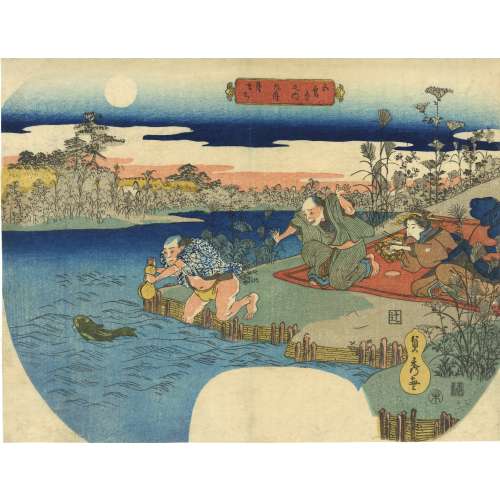 Artist: Utagawa Sadahide [歌川貞秀] (Japanese, 1807 – 1879). Publisher: Iseya Ichiemon [伊勢屋市右衛門] (Japanese, fl. c. 1820s – c. 1860s). Size: Uncut fan print (uchiwa-e), 220 x 285 mm. Date-kiwame seal: 1835 (Tenpō 6). Signed: Sadahide ga in a double-gourd cartouche. Man trying to catch a catfish with a gourd during a picnic on an autumn evening. Five Festivals [五節句の內] (Gosekku no uchi), Ninth Month [九月] (Kugatu), Full moon celebration on the 15th night of the month (Tsuki machi) [月まち] or [月待]. The autumnal spirit is also supported by the presence of Patrinia scabiosifolia (ominaeshi) [女郎花] and Miscanthus sinensis, or Japanese pampas grass (susuki) [薄]. These two are part of the Seven Grasses of Autumn (aki no nanakusa) [秋の七草]. Description by Richard Kruml: "Viewing the full moon in the eighth and ninth months was a popular activity passed down from the aristocracy in Heian times; especially where the moon's reflection could be seen in the water. One such party is seen here where a member vainly attempts to catch a catfish with a gourd: A hopeless task with such an unsuitable utensil. This is based on a Zen riddle posed by the shōgun Ashikaga Yoshimochi [足利 義持] (Japanese, 1386 – 1428) on how to catch a catfish with a gourd, which inspired the 15th-century artist Josetsu [如拙] (Japanese, fl. 1405 – 1496) to paint the subject with accompanying poems on the conundrum by Zen monks".
Artist: Utagawa Sadahide [歌川貞秀] (Japanese, 1807 – 1879). Publisher: Iseya Ichiemon [伊勢屋市右衛門] (Japanese, fl. c. 1820s – c. 1860s). Size: Uncut fan print (uchiwa-e), 220 x 285 mm. Date-kiwame seal: 1835 (Tenpō 6). Signed: Sadahide ga in a double-gourd cartouche. Man trying to catch a catfish with a gourd during a picnic on an autumn evening. Five Festivals [五節句の內] (Gosekku no uchi), Ninth Month [九月] (Kugatu), Full moon celebration on the 15th night of the month (Tsuki machi) [月まち] or [月待]. The autumnal spirit is also supported by the presence of Patrinia scabiosifolia (ominaeshi) [女郎花] and Miscanthus sinensis, or Japanese pampas grass (susuki) [薄]. These two are part of the Seven Grasses of Autumn (aki no nanakusa) [秋の七草]. Description by Richard Kruml: "Viewing the full moon in the eighth and ninth months was a popular activity passed down from the aristocracy in Heian times; especially where the moon's reflection could be seen in the water. One such party is seen here where a member vainly attempts to catch a catfish with a gourd: A hopeless task with such an unsuitable utensil. This is based on a Zen riddle posed by the shōgun Ashikaga Yoshimochi [足利 義持] (Japanese, 1386 – 1428) on how to catch a catfish with a gourd, which inspired the 15th-century artist Josetsu [如拙] (Japanese, fl. 1405 – 1496) to paint the subject with accompanying poems on the conundrum by Zen monks".


